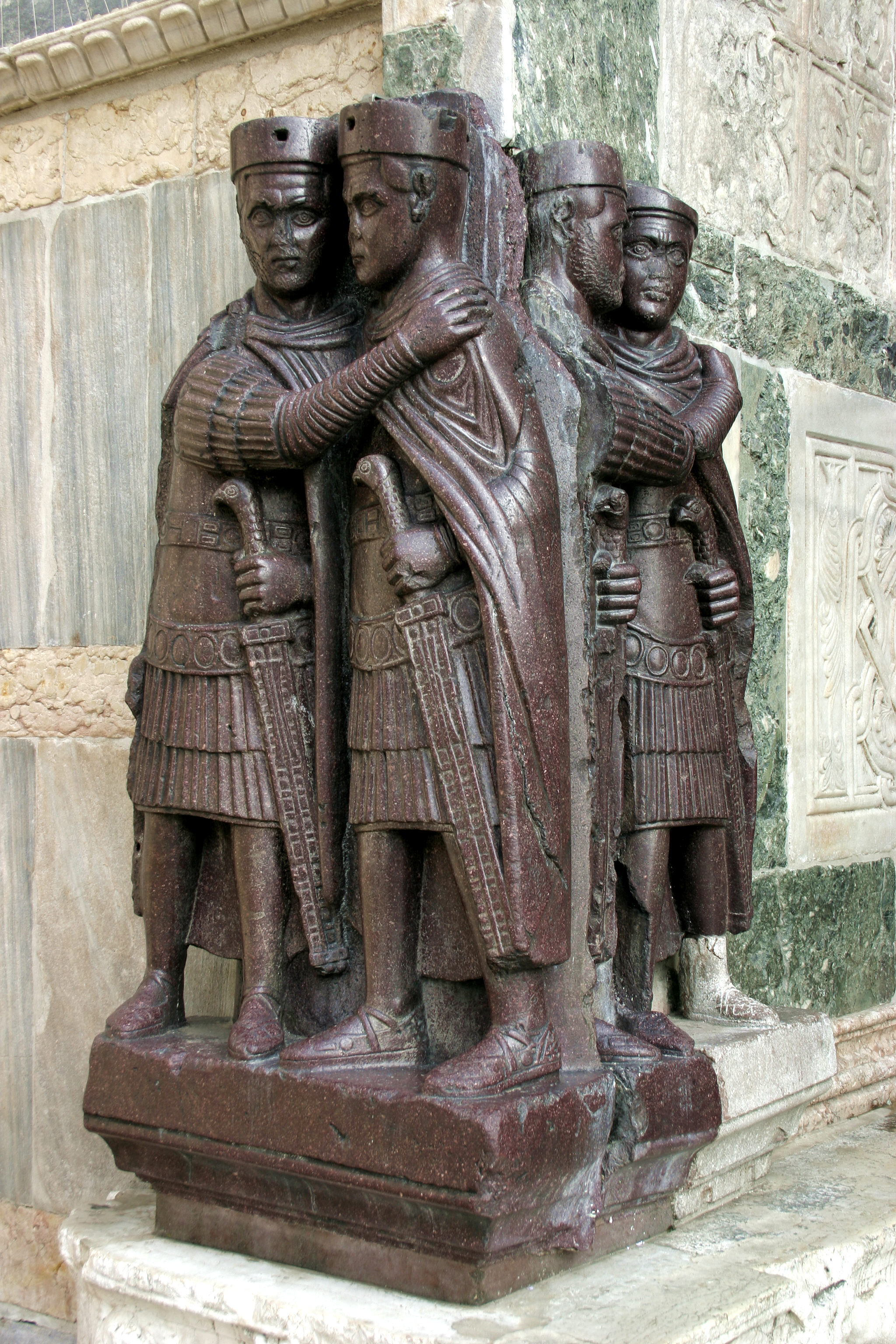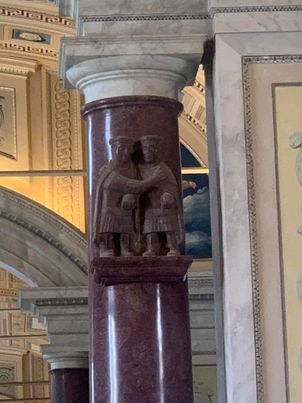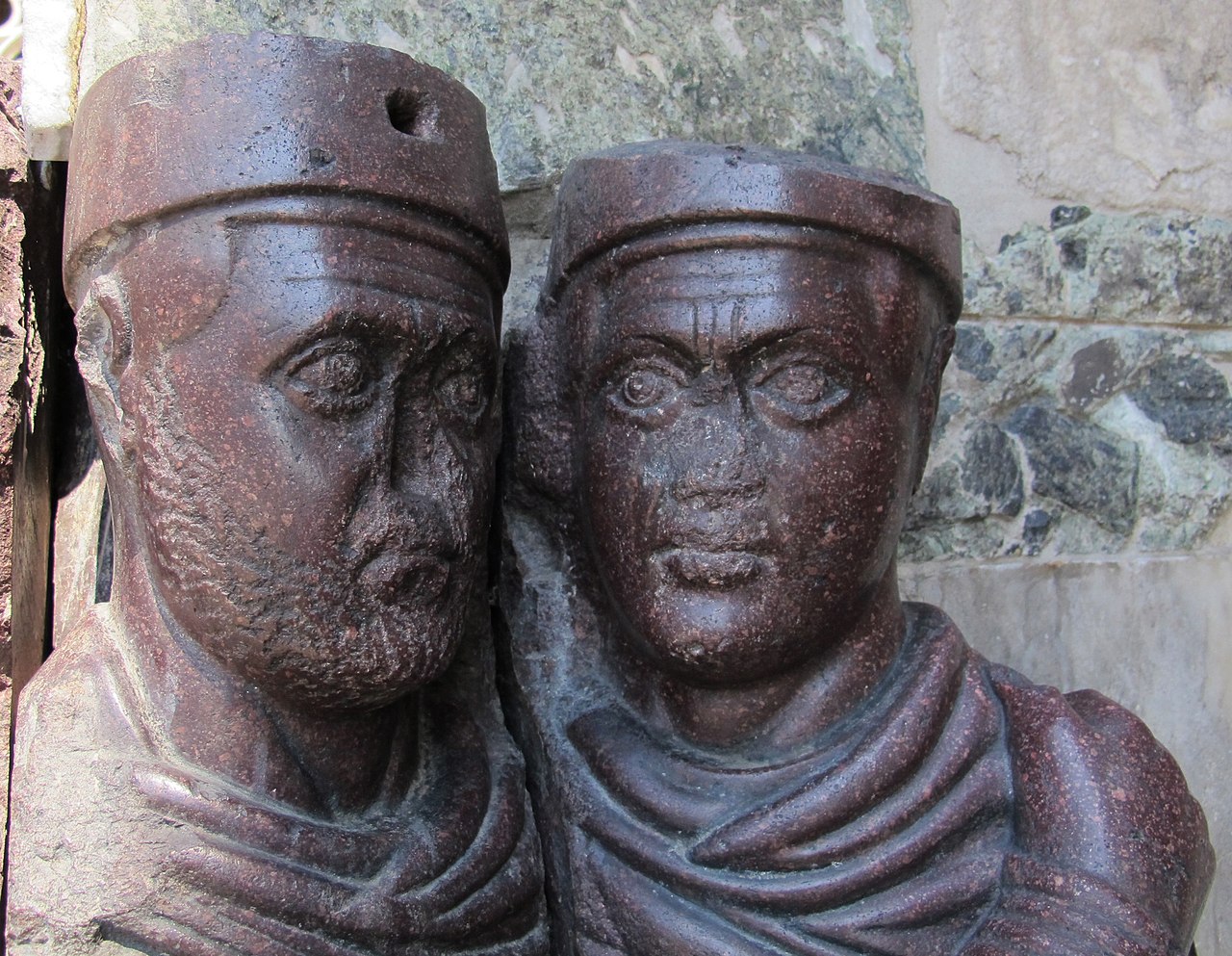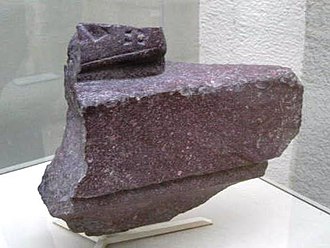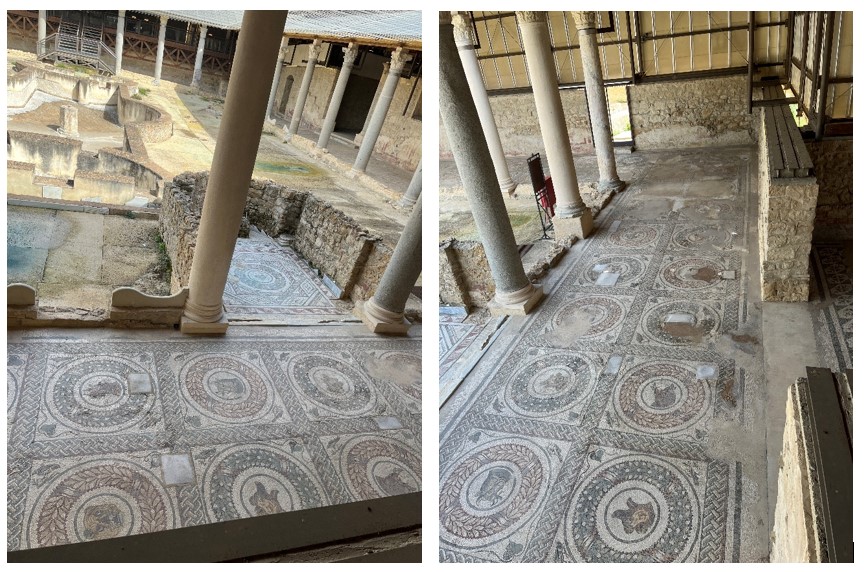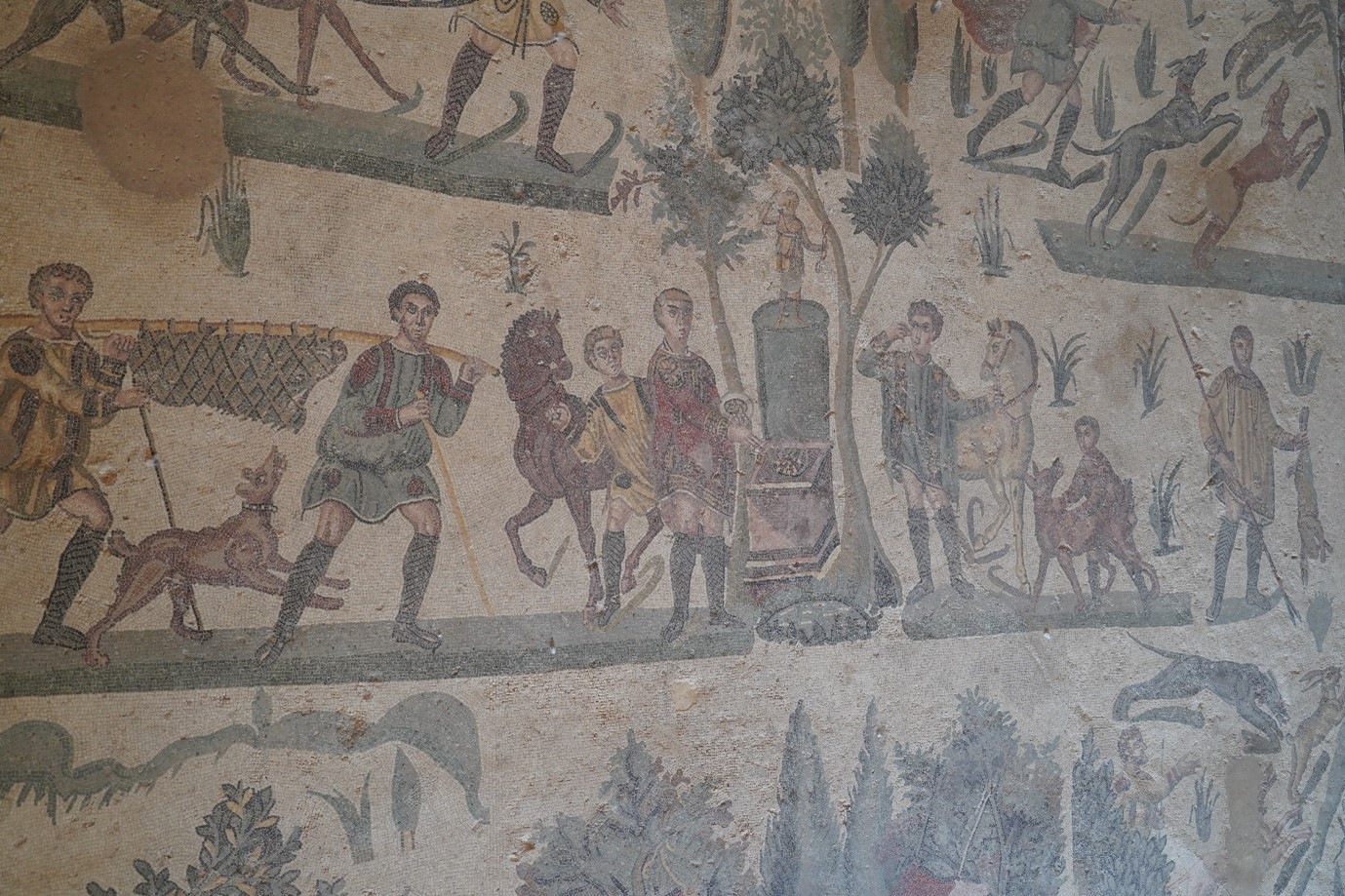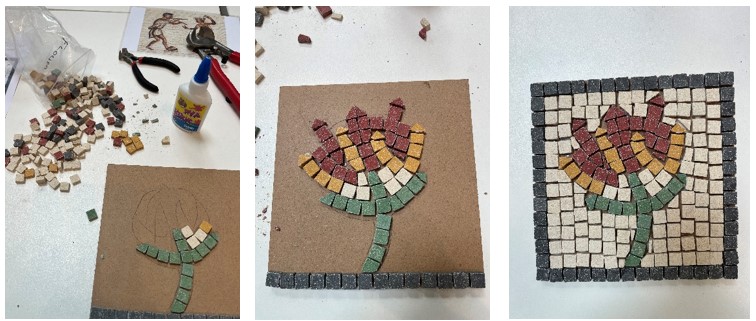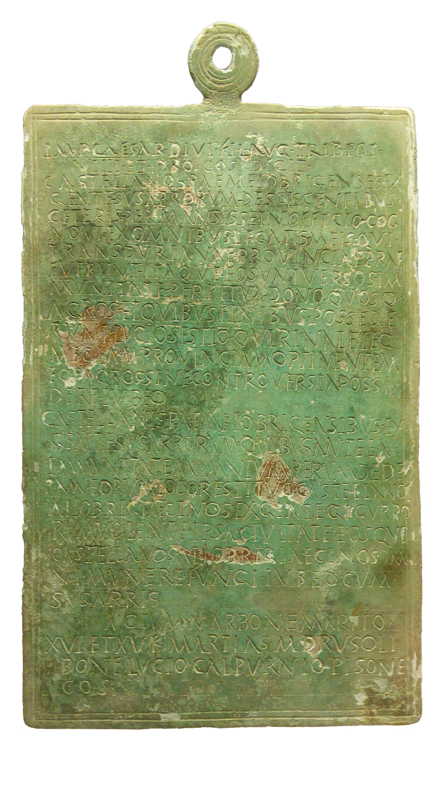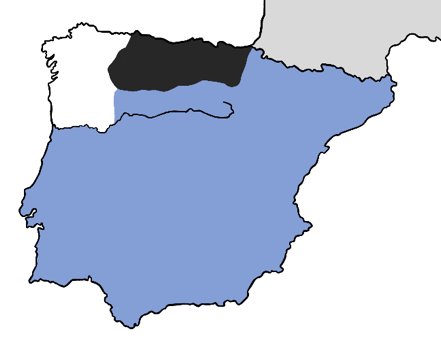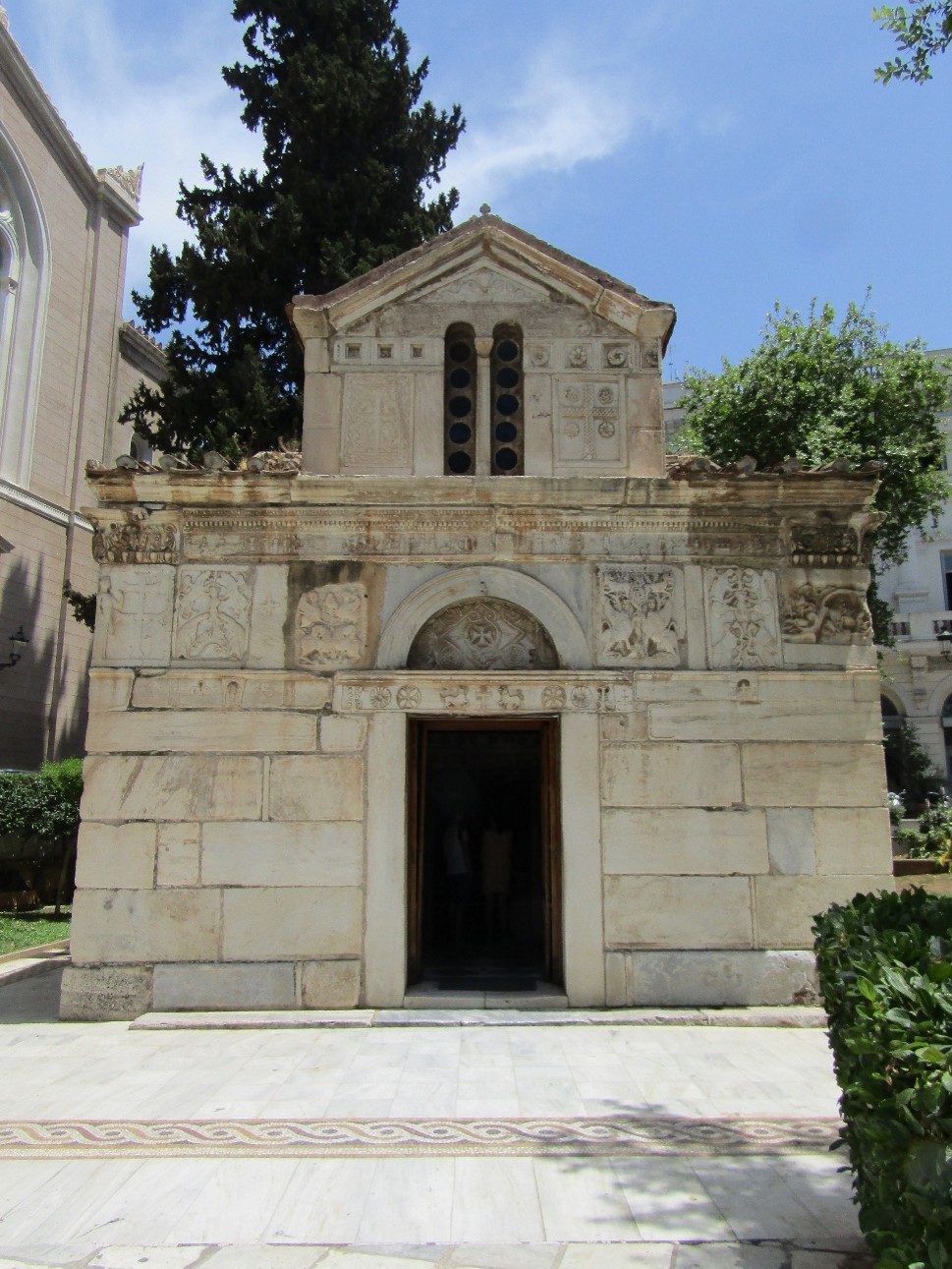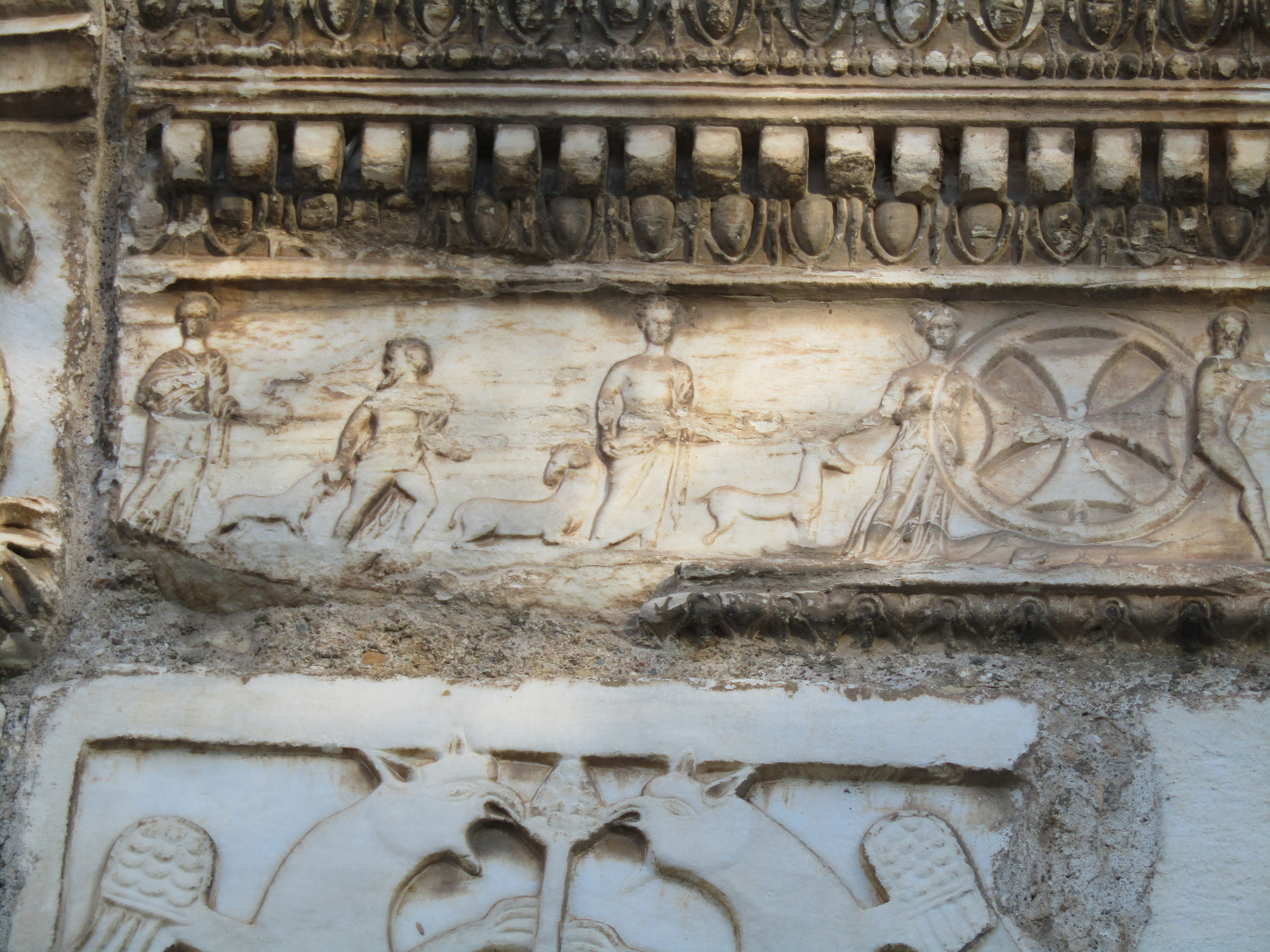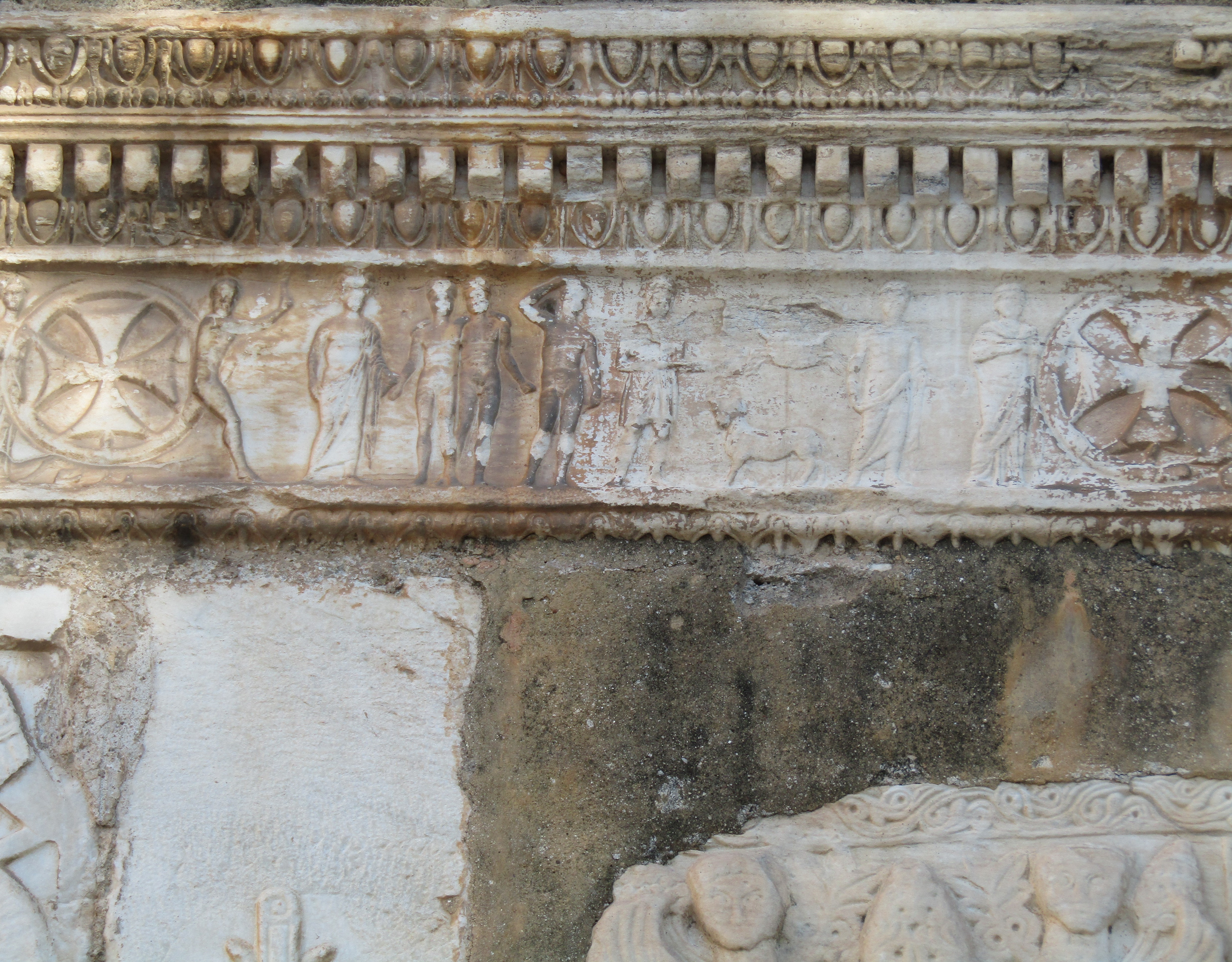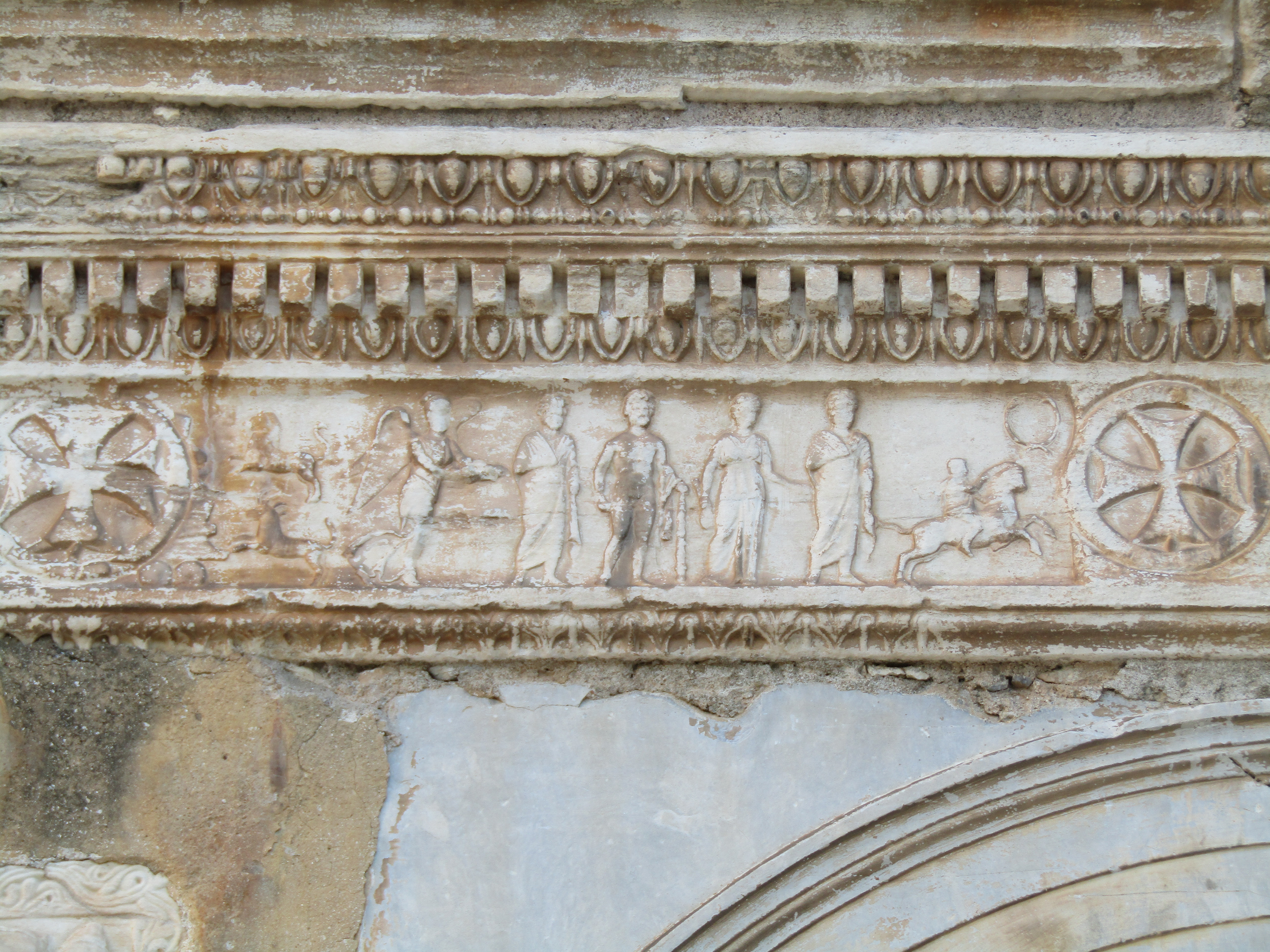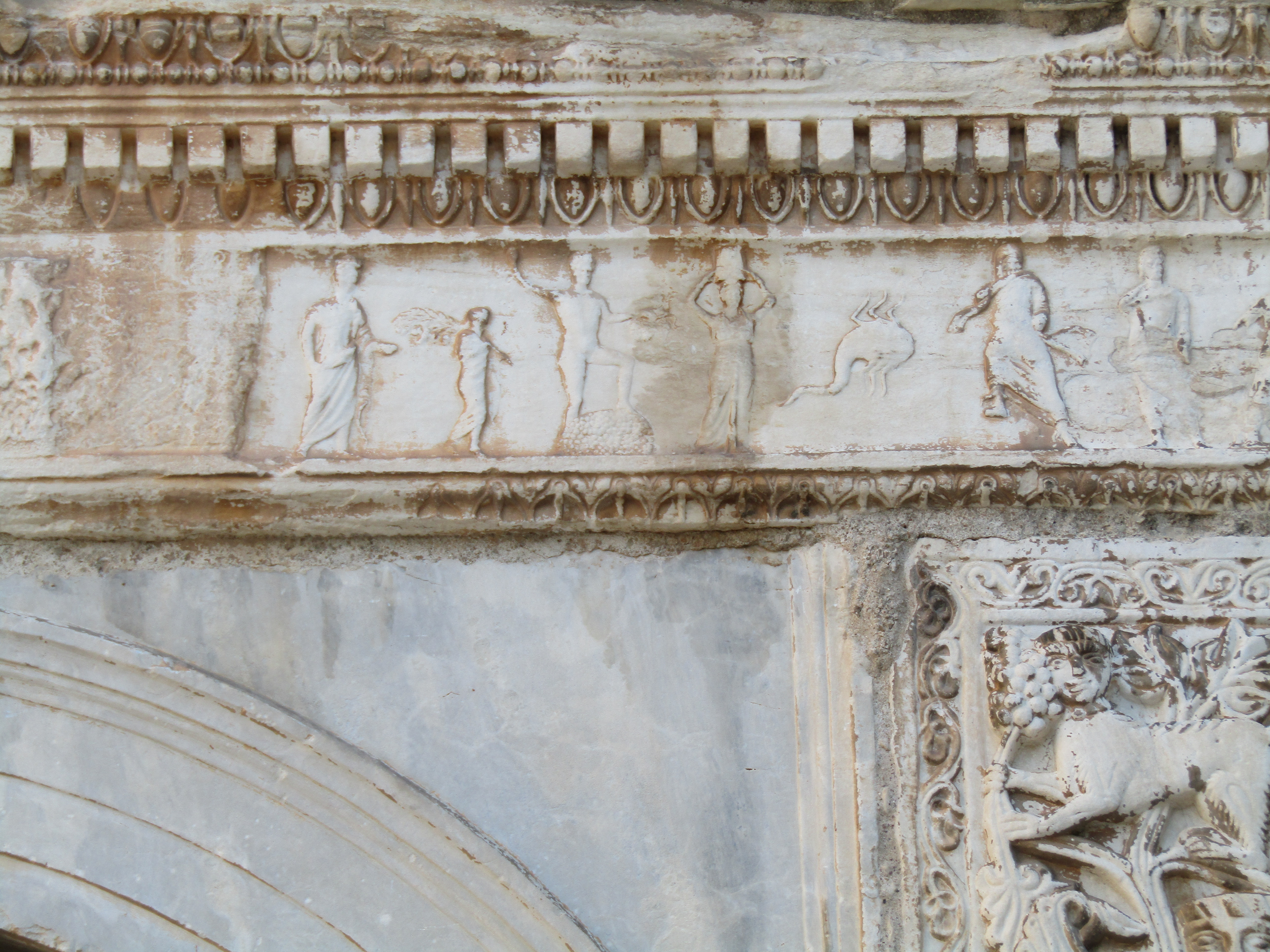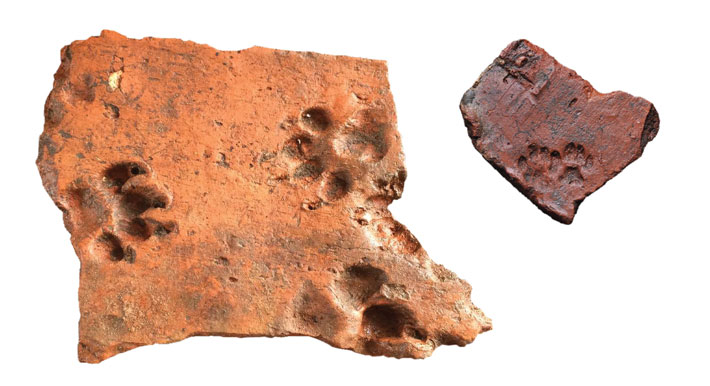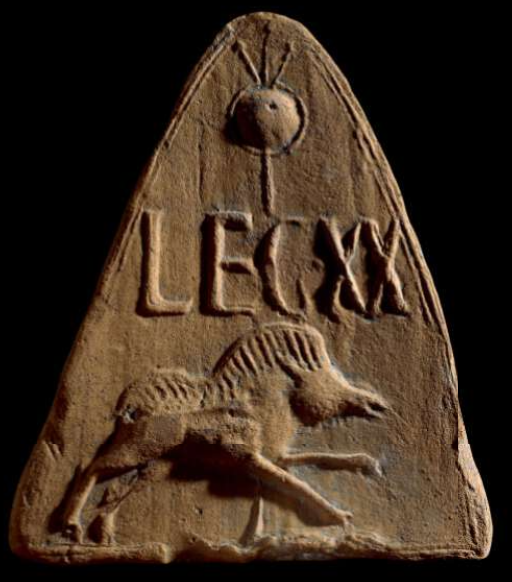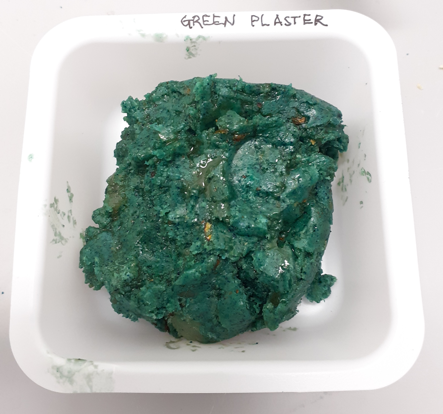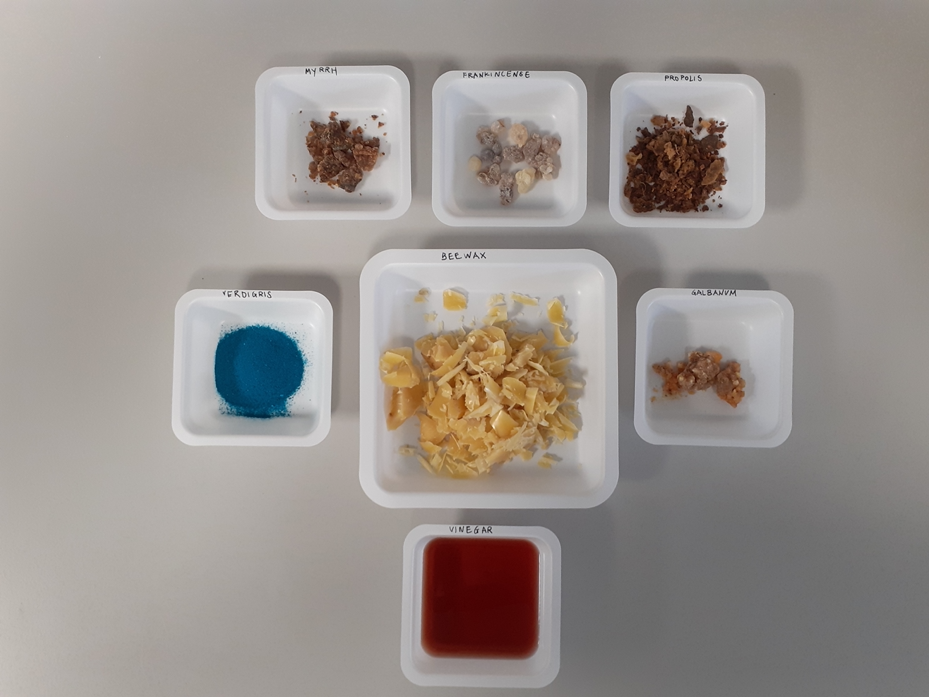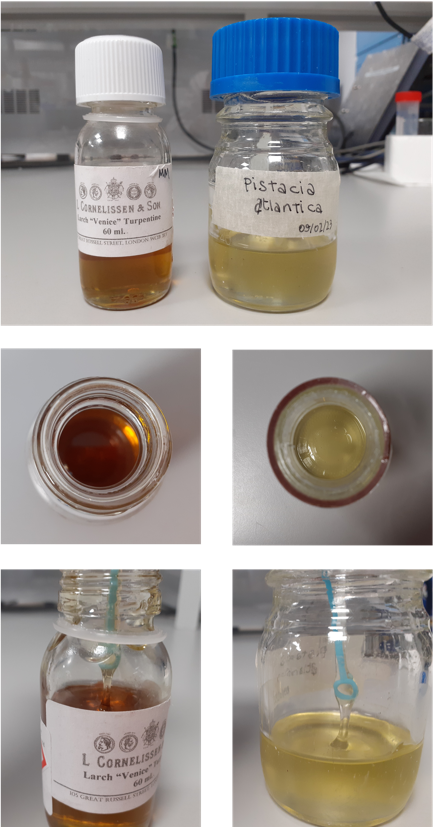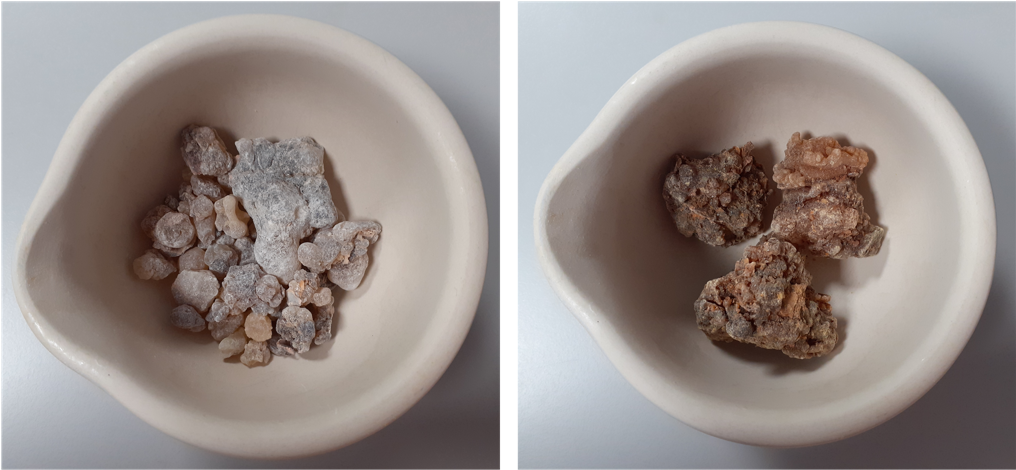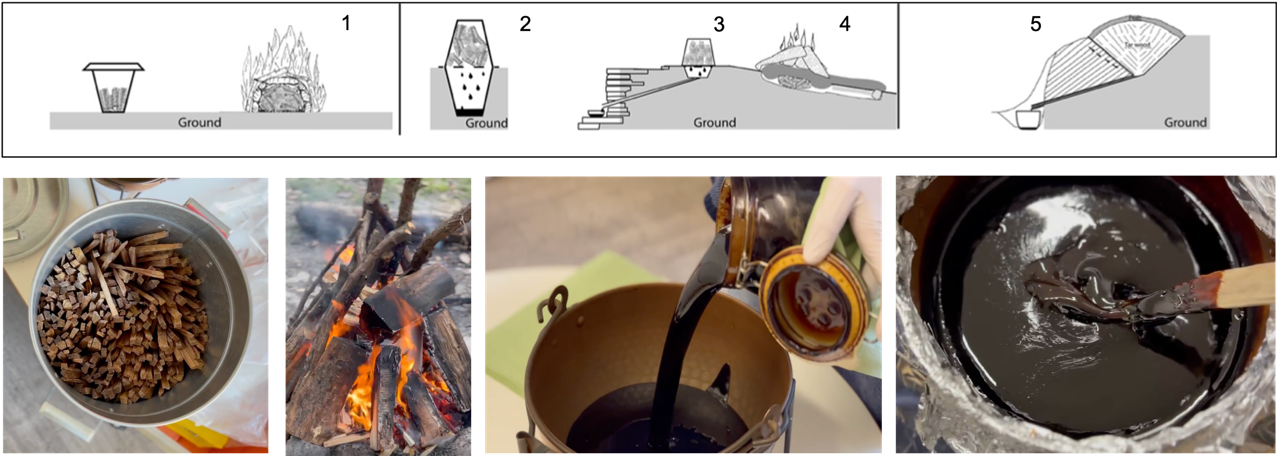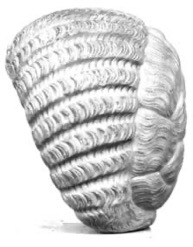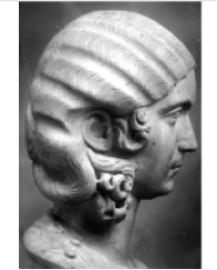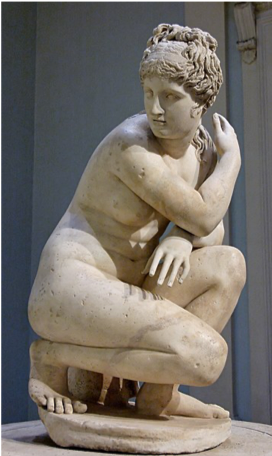2023

January - 'The Male Gaze Made Marble? The Venus de Milo' by Katharine Broderick
February - 'Hair today, gone tomorrow: imperial trendsetters' by Tallulah George
July - 'Magnificent and Modest – Mosaic Musings' by Jacqui Butler
August - 'Over-analysing a statue: Tetrarch Edition' by Peter Novis
October - 'The Great Altar of Pergamon: Telephus, the Wounded King and Mythical Founder' by Elena Claudi
November - :'Roman priesthood regalia: the bust-crown' by Rocío Gordillo Hervás
Roman priesthood regalia: the bust-crown, by Rocío Gordillo Hervás (November 2023)
During Roman times, religious ceremonies in honour of the deities were presided over according to specific rules. Public celebrations were typically entrusted to one of the city magistrates. For example, in the city of Rome, the priest was usually a member of the senate who was temporarily invested with religious powers. During the various ceremonies held by the Roman cities within their festive calendar, the highest religious authorities were easily distinguishable by means of their apparel. One of their most distinctive adornments, and the one we will be focusing on, was the crown decorated with small busts. One of the latest examples of this headgear was found during the 2002 excavation campaign near the City Eleusinion, an area close to the Athenian Agora. The piece (Fig. 1.) is a sculptural head of an unidentified figure wearing a crown adorned with eight busts (Agora S 3500).
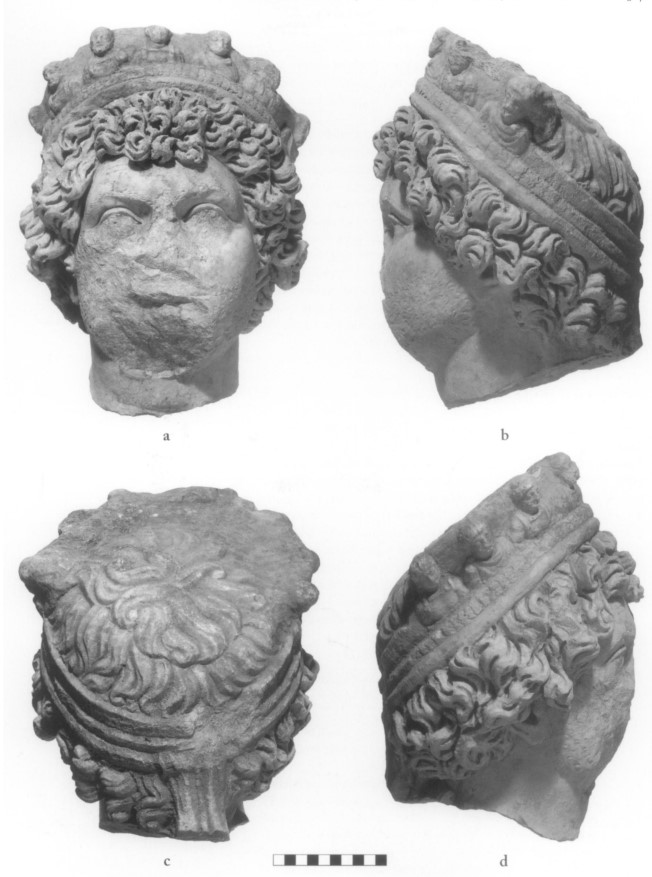
Fig. 1. Sculpted head wearing crown adorned with bust heads.
Image: Riccardi, L.A. 2007. “The Bust-Crown, the Panhellenion, and Eleusis: A New Portrait from the Athenian Agora”, Hesperia: The Journal of the American School of Classical Studies at Athens 76.2, 365-390, p. 367.
According to literary testimonies, this type of adornment was used by both emperors and priests to exemplify their function within a given celebration. As Suetonius states, during the Capitoline games in Rome, the emperor Domitian was said to be "wearing upon his head a golden crown with figures of Jupiter, Juno and Minerva, while by his side sat the priest of Jupiter and the college of the Flaviales, similarly dressed, except that their crowns bore his image as well" (Suet. Dom. 4.4., transl. by J.C. Rolfe). According to the text, the emperor wore a crown with the images of the main gods of Rome, while the crown worn by the priests also included the effigy of the reigning emperor himself. Suetonius' passage implies that the busts on the crowns could represent different personages, which in J. Rumscheid's study are organised into various typologies according to the figures depicted on the crowns, such as: 1) crowns with busts only with figures of divinities, 2) crowns with busts of divinities and members of the imperial family and, 3) crowns with busts only of members of the imperial family, among others.
This type of accessory is also mentioned in a number of inscriptions that describe the religious rituals that were celebrated in various cities. An example of this can be found in a famous inscription from the 2nd century AD found in the city of Oenoanda, in the province of Lycia (Wörrle 1988). In this text, C. Iulius Demosthenes, secretary of the boule of the Oenoandians, promises to his fellow citizens that he would organize a new festival. This section of the inscriptions describes in detail all the organisational elements of the new festivities known as the Demostheneia, such as how the games were to be financed, the schedule of the various competitions, the budget for the expenses for the ceremonies, as well as the personnel necessary for their proper implementation. One of these provisions indicates that the agonothetes will "in addition at his own expense make ready and dedicate to the city a Golden Crown carrying relief portraits of the emperor Nerva Trajan Hadrian Caesar Augustus and our leader the ancestral god Apollo, which the agonothete will wear" (transl. by St. Mitchell). In this case the agonothetes, as the person in charge for the games, is the one who had to wear the crown with the busts of the emperor Hadrian, who gave his approval for the celebration of the new games, and of Apollo, the main deity of the city. As we can learn from the inscription, the crown with busts, as a distinctive sign of both the priest of the imperial cult and the agonothetes, was to be worn not only during the Demostheneia, but also in most of the religious rituals that were organised by the city: “The agonothetes should wear the previously mentioned gold crown and a purple robe, and at the beginning of the New Year should make the ceremonial entrance, performing the pious rituals for the emperor and the gods of the home land on the Augustus days of month Dios and processing in company with the other magistrates, and he should take a front seat at meetings of the council and the assembly and at shows, wearing the previously mentioned attire” (Transl. St. Mitchell).
The busts-crowns are not uncommon and are represented in sculptures, reliefs and coins. One coin (Fig. 2.) of the third century shows on its reverse not just one but a double crown worn by the high priest of the province of Cilicia, who was in charge of the religious ceremonies of the region, including the rituals in honour of the Roman emperors.
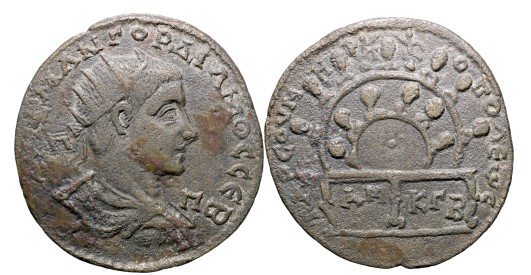
Fig. 2. Coin, RPC VII.2, 3044. Gordian III, showing double crown on the reverse.
Image: https://rpc.ashmus.ox.ac.uk/coins/7.2/3044
The first and larger crown sports seven busts, while the inner crown, of smaller dimensions, shows only six. This adornment is also represented within the honorific inscription of Marcus Ulpius Apuleius Eurykles found in the stadium of Aizanoi (Phrygia) from the 2nd century AD. The text lists the various offices that he held during his political career, and most interestingly each of these offices is inscribed within the relief representation of a crown. Each of these crowns has a different decoration and different characteristics that relate directly to the office that is inscribed in it. An example of this is the office of archiereus, or high priest of Asia, which appears inside a crown with ten small busts which, although difficult to identify, are likely to represent the imperial family and/or some of the most representative divinities of the Asian koinon.
Based on the above, the young male of the sculpture found in the City Eleusinion and mentioned at the beginning of this entry must have held some kind of religious office within the city. According to the study of the remains, L.A. Riccardi suggests that the busts represent some of the male members of the imperial family, more specifically from the Antonine and Severan dynasties. She finds it likely that the piece was linked to the league of the Panhellenion, a league founded by the emperor Hadrian in the year 131/2 AD in Athens in connection with the ceremonies for the inauguration of the temple of Zeus Olympios. The league included among its members many cities, culturally and geographically very diverse, from the provinces of Achaia, Macedonia, Crete-Cyrene, Asia or Syria. Each city was represented by one or more panhellenes chosen by the city to attend the sessions of the league in Athens. The league was presided by an archon, who was elected every four years, and an agonothetes was in charge of the Panhellenian games which were hosted by Athens and which were first celebrated in the year 137 AD. Thus, L.A. Riccardi suggests that the person who was wearing the bust-crown was an archon or an agonothetes of the Panhellenia.
Clothing and other types of apparel were important elements for distinguishing priests and other figures in charge of religious ceremonies during Roman times. One of the most representative headdresses for these high religious positions, the bust-crown, not only displayed the wearer’s position and his devotion towards the city’s deities but, in the case of crowns with imperial busts, his loyalty to the Roman emperor himself.
Bibliography:
Mitchell, Stephen. 1990. “Festivals, Games and Civic Life in Roman Asia Minor”, Journal of Roman Studies 80, 183-193.
Price, S.R.F. 1984. Rituals and Power: The Roman Imperial Cult in Asia Minor. Cambridge.
Riccardi, L.A. 2007. “The Bust-Crown, the Panhellenion, and Eleusis: A New Portrait from the Athenian Agora”, Hesperia: The Journal of the American School of Classical Studies at Athens 76.2, 365-390.
Rumscheid, J. 2000. Kranz und Krone. Zu Insignien, Siegespreisen und Ehrenzeichen der RömischenKaiserzeit. Tübingen.
Spawforth, A.J. y Walker, S. 1985. “The World of the Panhellenion I: Athens and Eleusis”, Journal of Roman Studies 75, 78-104.
Spawforth, A.J. y Walker, S. 1986. “The World of the Panhellenion II: Three Dorian Cities”, Journal of Roman Studies 76, 88-105.
Wörrle, M. 1988. Stadt und Fest in kaiserzeitlichenKleinasien. Studien zu eineragonistischen Stiftung ausOinoanda. Munich.
Wörrle, M. 1992. “Neue InschriftenfundeausAizanoi I”, Chiron 22, 337-376.

This post was written by Rocío Gordillo Hervás who is a Lecturer at the University Pablo de Olavide (Spain). She successfully completed her research doctorate at the Università degli Studi di Firenze. She is currently the main researcher, together with Prof. Elena Muñiz Grijalvo, of the project “Celebrations of the Empire from the provinces” hosted by the University Pablo de Olavide and financed by the Ministerio de Ciencia e Innovación, Government of Spain. Rocío was Visiting Research Fellow at the University of Warwick for the year 2022.
The Great Altar of Pergamon: Telephus, the Wounded King and Mythical Founder, by Elena Claudi (October 2023)
The Pergamonmuseum in Berlin completely closed for restoration on the 23rd of October 2023 and it will not be possible to visit it for several years, including the Great Altar of Pergamon, one of its most spectacular monuments, which has already been inaccessible for almost ten years. In this post, we can try to compensate for this closure by exploring it virtually.
The Altar is an imposing monument (measuring 36.44m x 34.20m) with a U shape and was dedicated to Zeus and Athena Nikephoros by Eumenes II (197-158 BC), king of Pergamon, in modern-day Turkey (Fig. 1.). This altar celebrated not only the victory over the Gauls in 166 BC, but also the royal family of Pergamon. The external frieze represents the Gigantomachy, namely the mythical war between the Greek Gods and the Giants, who dared to challenge the Gods' supremacy. It highlights the importance of the victory over the Gauls and its symbolic meaning of the universal triumph of order over barbarian forces. If we go up the monumental staircase, we enter the sacrificial altar with an internal frieze. It represents the story of Telephus, who was considered the mythical founder of Pergamon, through a series of panels.
Fig. 1. Model of the Altar of Pergamon. Image: C. Raddato, Wikimedia Commons, CC-BY-SA 2.0.
There are various versions of the Telephus myth, but we can summarise it as follows: Telephus is the son of Auge, daughter of the king of Tegea (in Arcadia), and Heracles, but after his birth, he is exposed on Mount Parthenion, because a prophecy foretells that he will kill his maternal uncles. However, Telephus survives thanks to a hind that nurses him, until he is found by some shepherds and he is then raised by king Corythus. When Telephus grows up, he discovers his real origins, goes to Mysia, in modern-day Turkey, and becomes king. However, during the Trojan War, the Achaeans land in Mysia thinking by mistake that it is Troy and attack Telephus and his army; Telephus is wounded by Achilles but is also healed by him.
Many panels of this internal frieze are worth analysing, although I would like to focus on panels 39 and 40 which show the episode of Telephus’ myth related to the Trojan War (Fig. 2.). Telephus is sitting on the right, is bare-chested with a chiton around his waist and is pointing to the wound on his thigh. On the left there are three men seated, perhaps Agamemnon, Nestor and Menelaus, and one of them is holding a sceptre. Next to Telephus, in the background, there is a man holding a spear, probably Achilles. This scene also represents Odysseus with Pilos and a servant who is bringing fruit on a plate.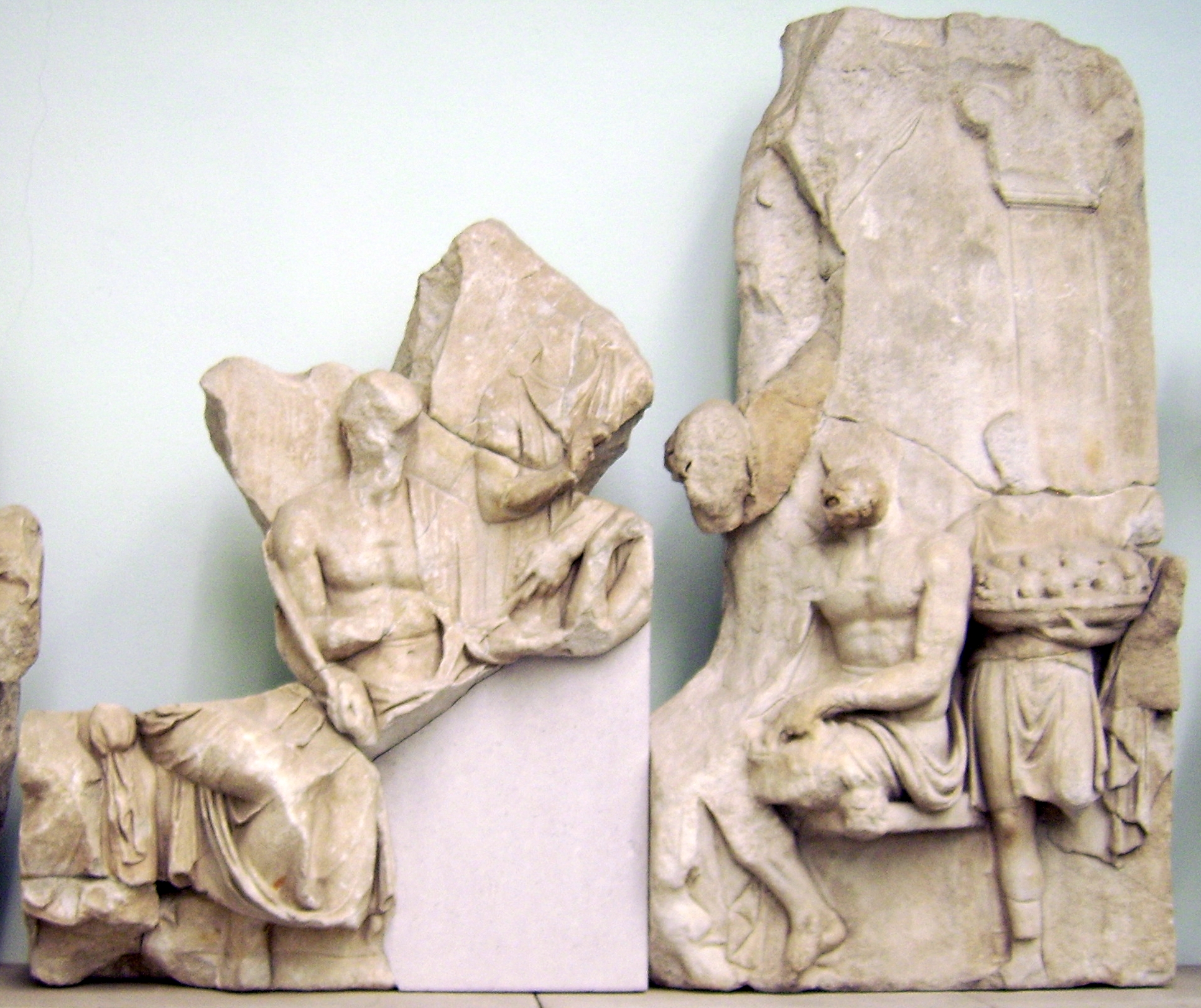
Fig. 2. Panels 39 and 40, Telephus Frieze, Altar of Pergamon, Pergamonmuseum, Berlin. Image: M. Cyron, Wikimedia Commons, CC-BY-SA 3.0.
Telephus is lame because of the wound that Achilles inflicted on him and, therefore, he is depicted seated or, in other representations, uses a stick. Why did the Attalids choose to celebrate a wounded king as Pergamon’s mythical founder? In ancient Greek myths, many heroes, like Telephus, who had been severely wounded to the lower body, were excluded from society because of their physical condition, but, at the same time, this impairment was also considered a mark of an extraordinary destiny. Philoctetes, another hero of the Trojan War, is a clear example of this: he is abandoned by the Achaeans on the deserted island of Lemnos because a snake bite to his foot caused him an incurable and rank wound. However, an oracle reveals that Philoctetes and his bow are fundamental to determining the victory of the Achaeans over the Trojans. This borderline condition, between exclusion and exceptionality, can apply also to Telephus. The vicissitudes of the hero were known since the archaic and classical eras and were represented on stage by Aeschylus, Sophocles and Euripides, but we only have a few fragments of these tragedies. Euripides’ Telephus (438 BC) is the better-preserved work and shows the wounded Telephus in the Achaeans’ camp dressed in rags as a beggar, who has fallen into disgrace because of his wound, to beg them to heal his pain (Euripides, Telephus ffr. 696-698, 714). Telephus’ extremely miserable condition in Euripides’ tragedy is parodied by Aristophanes in his Acharnians (425 BC). Here there are numerous references to the Euripidean Telephus; in particular, we can mention when the comic hero Diceopolis asks Euripides for the rags of Telephus so that he can appear as a miserable man and thus effectively defend himself from the accusation of treason (Aristophanes, Acharnians 410-478). The popularity of the Telephus myth in the 5th-4th centuries BC is confirmed by the tragedies dedicated to his narrative as well as numerous ancient vases that represent the wounded king while he is threatening the Achaeans to kill the infant Orestes in order to have his wound healed (Figs. 3.-4.).
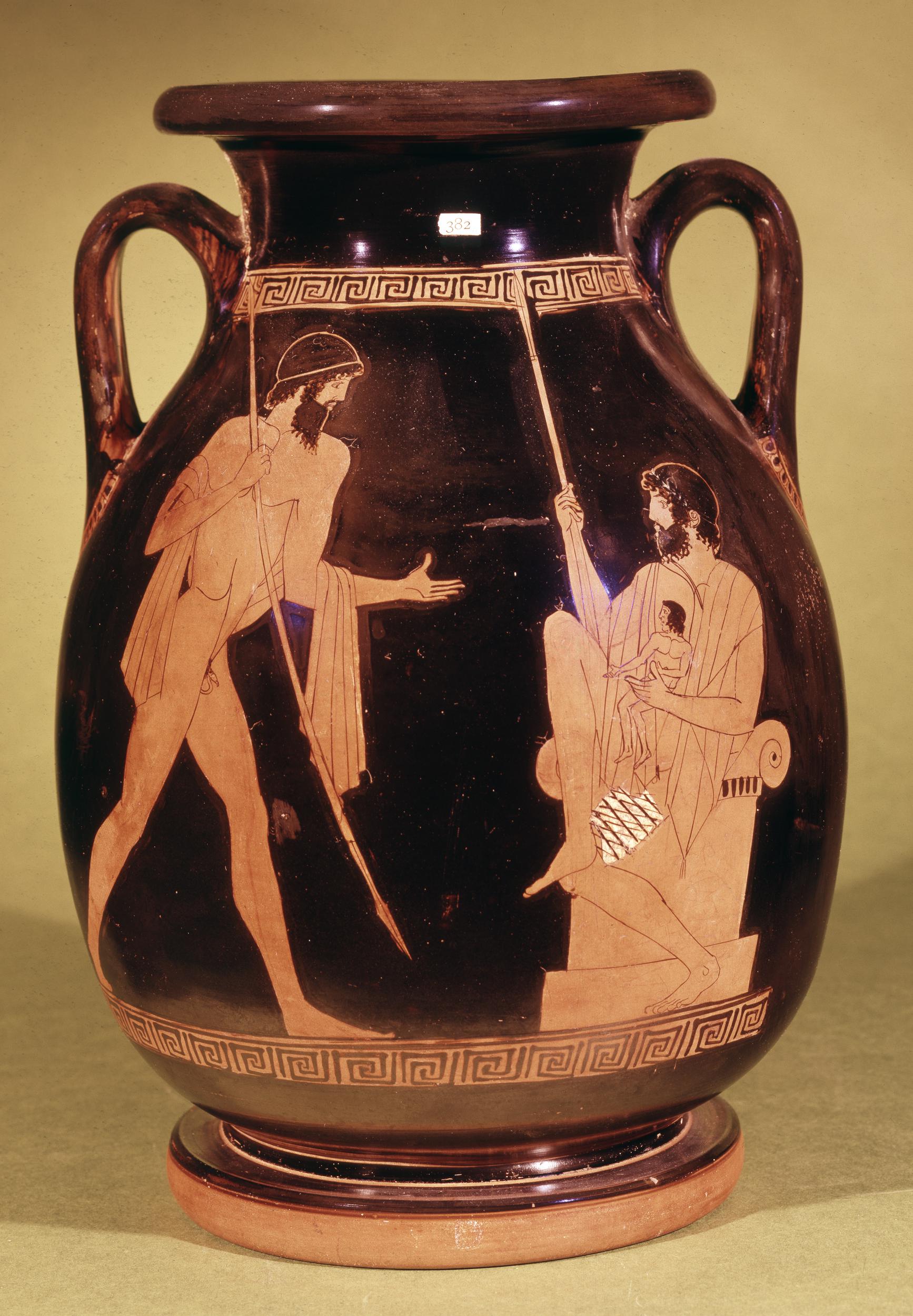
Fig. 3. Red-figure pelike, Agamemnon and Telephos (back: satyr and maenad), 450 BC, British Museum Inv. No. 1836,0224.28, London. Image: British Museum, CC-BY-SA.4.0.
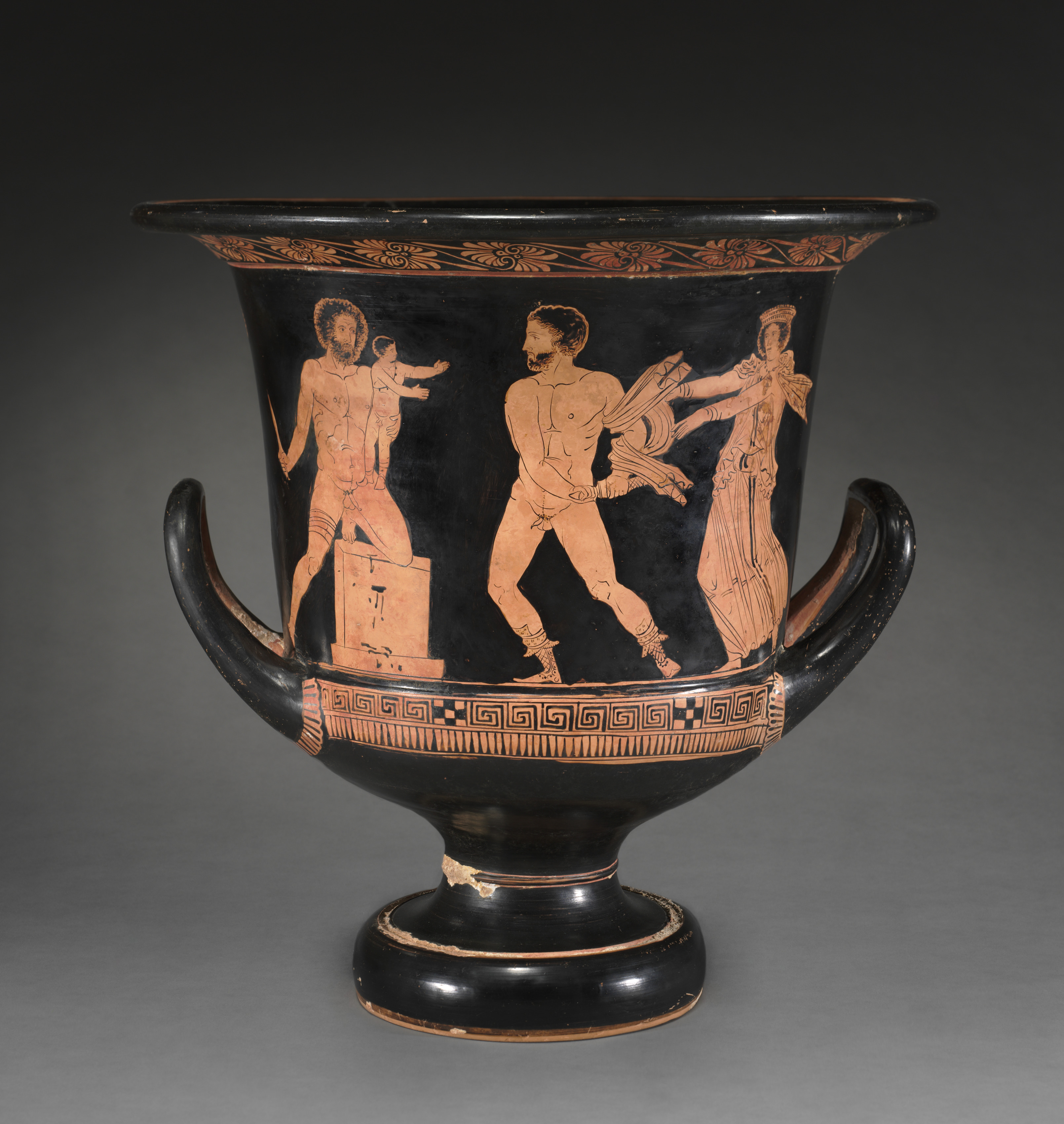
Fig. 4. Red-figured calyx-krater from Lucania, 400 BC. Cleveland Museum of Art, 91.1. Image: Cleveland Museum of Art, CC0 1.0.
Telephus is not only a hero who has fallen into disgrace, but he also plays a fundamental role in the Achaeans’ success: according to an oracle, he is the only person who can show the Achaeans how to arrive at Troy. However, in return, Telephus wants to have his wound healed. This can happen thanks to sympathetic medicine: the oracle of Delphi reveals to Telephus that only the person who had wounded him will heal him. The only remedy for Telephus' wound is thus Achilles who agrees to put the rust of his spear on Telephus’ thigh. This oracle has cultural significance in other contexts. For example, the sentence of Publilius Syrus (1st century BC) amoris vulnus idem sanat, qui facit, “the love wound is healed by the same person who has provoked it”, can be considered an ancient transposition of Telephus’ oracle in a romantic context (Publilius Syrus, Sententiae A 31). In Latin literature, the idea of the love wound that keeps tormenting the poet and can be healed only by the loved woman who caused it is very common among the elegiac poets.
The remedy of sympathetic medicine that was used to cure Telephus was well-known in the following centuries too. For example, the Life of Apollonius of Tyana (2nd-3rd centuries AD) by Philostratus tells of the travels and miracles of Apollonius and, among these, one is relevant to Telephus’ wound. A rabid dog bites a boy and he starts to behave like a dog: he walks on four feet, barks and howls. Apollonius finds the dog and makes it lick the boy’s wound so that what caused the wound can also heal it, similar to what happened with Telephus (Philostratus, Life of Apollonius of Tyana 6.43). In the English folkloric tradition, for example, the saying “the hair of the dog (that bit you)” derives from a similar belief that the hair of the dog that caused the wound can treat the bite.
Highlighting the interaction between art, literature and ancient culture can help us understand why the Telephus frieze and specifically the panels that we have considered were important parts of the Altar of Pergamon. As Telephus is a Greek hero, born from Heracles, and is a popular subject in Greek literary and artistic representations, especially during the classical era, his myth represents a cultural bridge between Asia Minor and mainland Greece. This connection reflected the desire of the Attalids to be considered the continuators of Athenian greatness and the Greek tradition, which is evident also in various elements of the Altar of Pergamon that recall the Athenian Parthenon. Moreover, the Altar shows the wounded Telephus as an important and extraordinary hero of the Trojan War, as he was miraculously healed and had a key role in guiding the Achaeans to Troy. This connection allowed the Attalids to display the relevance of their dynasty and compare Pergamon with both ancient Greek and Roman culture through their common link to the Trojan War. The legacy of Telephus appears to survive the end of the Attalid dynasty, when Pergamon became part of the Roman Empire, and continues to be relevant in cultural traditions of the following centuries.
Bibliography:
Primary Sources:
Aristophanes, Acharnians. Knights, ed. and trans. by Henderson, J. (Cambridge, MA: Harvard University Press, 1998).
Euripides, Fragments: Oedipus-Chrysippus. Other Fragments, ed. and trans. Collard, C. and Cropp, M. (Cambridge, MA: Harvard University Press, 2009).
Philostratus, Life of Apollonius of Tyana, ed. and trans. Jones, C. P. (Cambridge, MA: Harvard University Press, 2005).
Publilius Syrus, Sententiae in Tosi, R. (2017) Dizionario delle sentenze latine e greche (Milan: Rizzoli).
Secondary Sources:Barringer, J. (2015) The Art and Archaeology of Ancient Greece (Cambridge: Cambridge University Press).
Bettini, M. and Borghini, A. (1979) “Il bambino e l’eletto. Logica di una peripezia culturale” in Materiali e discussioni per l’analisi dei testi classici, 3, pp. 121-153.
Bettini, M. and Guidorizzi, G. (2004) Il mito di Edipo. Immagini e racconti dalla Grecia a oggi (Torino: Einaudi).
Brelich, A. (1958) Gli eroi greci, Un problema storico-religioso (Rome: Edizioni dell’Ateneo & Bizzarri).
Daxelmüller, C. (2007) “Similia similibus” in Ranke, K. et al., eds. (1977-2015), Enzyklopädie des Märchens: Handwörterbuch zur historischen und vergleichenden Erzählforschung, vol. XII (Berlin; New York: Walter de Gruyter), pp. 681-683.
Dignas, B. (2012) “Rituals and the Construction of Identity in Attalid Pergamon”, in Dignas, B. and Smith, R. R. R. eds. (2012) Historical and Religious Memory in the Ancient World (Oxford: Oxford University Press).
Frazer, J. G. (1920), The Golden Bough: A Study in Magic and Religion, The Magic Art and the Evolution of Kings (London: Macmillan).
Frazer, J. G. ed. (1921) Apollodorus. The Library, Volumes I and II (Cambridge, MA: Harvard University Press).
Goldberg, C. (2014), “Wunde” in Ranke, K. et al., eds. (1977-2015) Enzyklopädie des Märchens: Handwörterbuch zur historischen und vergleichenden Erzählforschung, vol. XIV (Berlin; New York: Walter de Gruyter), pp. 1031-1034.
Gruen, E. S. (2023) "Culture as Policy: The Attalids of Pergamon" in From Pergamon to Sperlonga: Sculpture and Context, de Grummond, N. T. and Ridgway, B. S. eds. (Berkeley: University of California Press), pp. 17-31.
Laes, C. ed. (2020) A Cultural History of Disability in Antiquity (London; New York: Bloomsbury).
Paduano, G. (1967) “Il motivo del re mendicante e lo scandalo del Telefo”, in Studi Classici e Orientali, 16, pp. 330-342.
Strauss, M. (1994) “Telephos” in Lexicon Iconographicum Mythologiae Classicae, vol.VII (Zurich; Munchen: Artemis), pp. 856-870.
Taplin, O. (1993) Comic Angels and other Approaches to Greek Drama through Vase-Painting (Oxford: Clarendon Press).

This post was written by Elena Claudi, a PhD candidate in the Department of Classics and Ancient History at the University of Warwick. Elena's interests are Greek literature, culture and mythology and her research focusses on the representation of identity and otherness in Greek ekphrasis of the imperial period.
Over-analysing a statue: Tetrarch Edition, by Peter Novis (August 2023)
Fig. 1. A full-length photo of the Portrait of the Four Tetrarchs. Image: N. Barbieri, Wikipedia Commons, CC BY-SA 3.0.
Fig. 3. A photo of the Portrait of the Four Tetrarchs focusing on the faces of one pair. Image: I. Saiko, Wikimedia Commons, CC BY-SA 3.0.
On top of the lack of distinguishing physical features on the statues, the statues are divergent from the typical naturalism of antiquity in more obvious ways. They have been viewed as stubby and blocky and there is a sense weight, stiffness, and a lack of movement. The repetition between the two pairs is clear, particularly striking is the way they all hold their swords identically. The patterns decorating the armour of the tetrarchs is in a style more reminiscent of archaic or medieval art. This could be partially explained by the fact it depicts a divine type. The God Emperor tetrarchs have descended to our world and can be seen in a form perfectly regulated by facial symmetry and repetition just as Diocletian will perfectly order and regulate the Empire through his reforms. In truth, styles were simply changing. The naturalism and idealism of earlier art was being shunned for the easy to exploit messaging possibilities that a simpler design presented, and, if I can read all of this into one statue, it clearly was very successful in its departure from what we may consider the typical style of classical art.
I hope this inspires a few questions: why is it now part of a church in Venice, why is it missing a foot and who does it actually depict? This statue has actually survived quite an adventurous life (rather unlike the short-lived political system it represented!) The original site where the statue was set up and its date is unknown, but it was taken to Constantinople by Constantine in the late 320s AD as he relocated numerous famous artworks to his new capital. During this time in Constantinople the statue’s foot was lost, but it was found in the 1960s and is now on display in the Istanbul Museum of Archaeology and can be seen in Fig. 4. According to a Byzantine text, a public square, where the statue was displayed, was named the Philadelphion (place of brotherly love) because the author and his contemporaries believed the statue depicted Constantine’s sons. In 1204 AD the statue was then looted by the Venetians during the fourth Crusade and was taken to St. Mark’s Basilica. Finally, in terms of the identity of the four figures, a few theories have been suggested. The above-mentioned Byzantine source believed it showed the sons of Constantine, though this is now largely dismissed. It is possible that these statues could represent any group of four tetrarchs. However, given the statues lack any identifying features perhaps its best to understand them as not even representing any real people but just the divine types of the Augusti and Caesar as the tetrarch system of Diocletian envisioned them.
Fig. 4. A photo of the missing foot of the Portrait of the Four Tetrarchs which is now in the Istanbul Archaeological Museum. Image: Gryffindor, Wikimedia Commons, CC BY-SA 4.0.
Bibliography:
Primary Sources:
Constantinople in the Early Eighth Century: The Parastaseis Syntomoi Chronikai, trans. and eds. Cameron, A. and Herrin, J. (Leiden: Brill Academic Publisher, 1984)
Pliny, The Natural History, trans. Bostock J. (London: Taylor and Francis, 1855)
Secondary Sources:
Haynes, D. E. L. (1976) ‘A Late Antique Portrait Head in Porphyry’ in The Burlington Magazine Vol. 118 pp. 350-357.
Honour, H. and Fleming, J. (2009) A World History of Art (7th ed.) (London: Macmillan)
Kitzinger, E. (1977) Byzantine art in the making: main lines of stylistic development in Mediterranean, 3rd-7th century (Cambridge MA: Harvard University Press)
L’ Orange, H. P. (1965) Art Forms and Civic Life in the Late Roman Empire (New Jersey: Princeton University Press)
Tzortzaki, D. (2013) ‘Myth and the ideal in 20th c. Exhibitions of Classical Art’ in A Companion to Greek Art in eds. Smith, T. J., Plantzos, D. (New Jersey: John Wiley & Sons Ltd.) pp. 667-682.

This post was written by Peter Novis, a postgraduate student at the University of Warwick’s Department of Classics studying the MA in Visual and Material Culture in Ancient Rome MA. His interest revolves around Roman numismatics and the Roman economy. Most recently he has been looking at the imagery on coins minted by rebellions and how these interact and relate to Roman coins.
Magnificent and Modest – Mosaic Musings, by Jacqui Butler (July 2023)
Fig. 1. Peristyle area of villa with large ornamental pool and mosaic corridors featuring a repetitive grid pattern of animal/bird heads set within wreaths of laurel. Author’s own photographs.
The mosaicists are likely to have been from Carthage in North Africa due to the many and almost exact parallels in the designs with those in Carthage, as well as some floor designs being laid out using Punic measurements instead of Roman ones. Recent chemical analysis of a small number of glass tesserae (the small square pieces of cut stone or glass, which are used to form the mosaic imagery) from the villa may also support this theory, as one raw material component used in the production of the yellow tesserae, may have come from Djebel Slata in Tunisia, the only substantial deposit of the component within the confines of the Roman Empire. The extent to which the mosaics represent a unified thematic programme of decoration is another debated question, but there is certainly thematic connectivity in terms of relationship to games, spectacle, entertainment and leisure, as evidenced by the so-called Great Hunt, Small Hunt (Fig. 2.), Circus Races and of course the famous “Bikini Girls” to name a few. There are remnants of fresco painting on the walls which may also have contributed to thematic connectivity within specific rooms or areas.
Fig. 2. Detail from the Small Hunt mosaic, offerings being made to Diana prior to the hunt. Author’s own photograph.
Some mythological narratives feature in certain areas of the villa, and recently I have been looking at one depiction in particular. It appears in the large triple-apsed triclinium and has been debated as to whether it portrays Andromeda or Hesione (Fig. 3). Both characters were given as human sacrifices to appease sea monsters which were sent as divine retribution for offence caused. Andromeda’s mother Cassiopeia had boasted she was more beautiful than the Nereids, thus offending Poseidon, and Hesione’s father Laomedon (of Troy) had cheated Poseidon and Apollo (who had been disguised as mortals) out of their pay for building the walls of Troy (for the Andromeda narrative, see Ovid Metamorphoses, 4.668-770, and for Hesione, see Apollodorus, The Library 2.9). In both cases, oracles told the respective fathers that the only way to appease the ketos which ravaged their shores, was to offer their daughters to it. However, both myths have the ketos being slain by male heroes passing through and the women saved: Perseus saves Andromeda, and Hercules saves Hesione.
Fig. 3. Hesione or Andromeda, in threshold to north apse in triclinium. Image: Cordaro and Incardona (2002) p. 60.
Identifying the character definitively is difficult, given the absence of any accompanying characters or specific iconography, and also due to the similarities in the narratives as well as how the characters are sometimes depicted in different media in Roman art. It has often been understood as Hesione, due to the fact that the large central mosaic in the room depicts the labours of Hercules. However, Hercules is usually portrayed in combat with his adversaries, whereas in this highly unusual depiction, the hero does not appear at all, whilst his adversaries are shown dead or dying, writhing with blood flowing from their wounds. Instead, a scene showing his apotheosis (his elevation to divine status) appears in the north apse, with a threshold strip between the central mosaic and the apse depicting the metamorphoses of Daphne into the laurel tree, and Cyparissus into the cypress tree (see Ovid, Metamorphoses 1.452-567 and 10.106-143).
In the south apse opposite, there is a depiction of Lycurgus attempting to kill Ambrosia (the nymph who helped raise Dionysus) whilst she begins her metamorphosis into a vine (Nonnos, Dionysiaca, 21.1-62). The accompanying threshold imagery is fragmented here, but it has been suggested that this also featured metamorphoses, potentially of other characters into plants. The eastern apse features the death of the giants, with the threshold depicting the Hesione/Andromeda character, alongside Endymion. Those scholars who have suggested that it is Andromeda, have done so largely based upon the fact that Andromeda and Endymion are related to the celestial world – Andromeda as a constellation (Manilius, Astronomica 5.616-618); and Endymion, who was granted by Zeus to choose eternal sleep, remaining deathless and ageless (Apollodorus, The Library, 1.7.5.) and who also had a relationship with Selene (the goddess of the moon).
On balance, although it is highly unusual for Andromeda to appear without Perseus, the hypothesis that the character represents Andromeda seems more convincing for two reasons. Firstly, because she is visually represented much more than Hesione in Roman art and, secondly, due to her apotheosis into a constellation, providing a potential connection with the metamorphoses of the other characters who appear in the other thresholds. There is also the suggestion that the whole room represents victory over evil forces and perhaps even victory over death, which may also link the imagery.
Leaving mythology aside, to now consider some elements of mosaic production, via the experience of creating my own very modest mosaic at the mosaic-making workshop we had in the department, which was run by Laurence Payne from Roman Mosaic Workshops Ltd. After an introduction to the history of mosaics, Laurence introduced us to the key principles (consistency, fluidity and depth) and the seven key rules (size, spacing, keystone, convergence, borderline, offsetting and brick-wall) to making Roman mosaics, although in reality there was much variance in terms of implementation of these in actual mosaics.
We then began to make our mosaics using 10mm tesserae and adhering these to a board with a pattern which was already sketched on (thankfully in my case, although a few keen students created their own designs with great results). Although placing tesserae onto a pre-prepared image sounds easy, I can assure you it is not! Spacing is the first key issue and understanding that slightly offsetting the tesserae results in a better overall result. The second challenge is cutting the tesserae to the desired shape to create curves, closely followed by the placement technique – for the perfectionists amongst us this is a challenge as it is difficult to leave them alone and not keep repositioning them. Whilst my final mini mosaic may be somewhat lacking in terms of artistry and skill, practise and repetition was key to the ancient mosaicists developing both competence and expertise, as Laurence pointed out. The workshop was very useful in helping to understand some of the mechanics and challenges involved and to appreciate further the expertise of the mosaicists.
It took around 2 hours for us to complete our mini mosaics (Figs. 4. and 5.) and although I’m sure the ancient craftsmen would have been working much faster than we novices, and there would have been many workers creating the floors, both master mosaicists and assistants, it must have taken many months to complete the Piazza Armerina mosaics. It is also dusty work, and we were fortunate to be working on tables whereas at Piazza Armerina, they would of course have been working at ground level, which must have been uncomfortable over long periods of time. Although we were using modern water-based glue to adhere our tesserae, the challenge of keeping pieces in place whilst trying to fit others, is one which the ancient mosaicists must also have experienced as they placed each tessera by hand. Vitruvius (On Architecture, 7.1) gives the ideal rules for the preparation of the correct foundation and layout of mosaic pavements, and whilst the mosaicists may not have been involved in all of this foundational preparation, they planned the designs and made all the careful calculations necessary to achieve them, sometimes using incisions and guides made from lead strips, nails and string, or even painted sketches on the underlayer.
The abundant and magnificent mosaics preserved at the Villa del Casale at Piazza Armerina allow us to study them in a variety of ways; as artworks in their own right, but also to consider and question how they functioned within the space in which they appeared and their relationship to other adjacent imagery. This article has only (literally) touched the surface of what can be asked of these mosaics and of the villa itself. Whilst we may think we appreciate the beauty and splendour of Roman era mosaics when we see them in museums or in situ as at Piazza Armerina, considering the production process, and trying it out on a small scale as we did recently, really highlights the skill involved and gives an opportunity to value and celebrate the artistry and attention to detail of the mosaicists at La Villa Del Casale and elsewhere.
Bibliography:
Carandini, A., Ricci, A. and de Vos, M. (1982) Filosofiana, the Villa of Piazza Armerina. The image of a Roman aristocrat at the time of Constantine (Palermo, Flaccovio).
Cordaro, A. and Incardona, R. (2002) La Villa Romana del Casale, Morgantina: guida storica e artistica, nozioni sulle figure mitologiche mosaicate dei pavimenti e funzionalita dei vari ambienti (Barrafranca, Bose Giesse).
Croveri, I., Fragalà and Ciliberto, E. (2010) “Analysis of glass tesserae from the mosaics of the ‘Villa del Casale’ near Piazza Armerina (Enna, Italy). Chemical composition, state of preservation and production technology” in Applied Physics A, Materials Science & Processing, Vol. 100, Issue 3, pp. 927-935. https://0-link-springer-com.pugwash.lib.warwick.ac.uk/content/pdf/10.1007/s00339-010-5670-8
Di Bella, M., Quartieri, S., Sabatino, G., Stanalucia, F. and Triscari, M. (2014) “The glass mosaics tesserae of “Villa del Casale” (Piazza Armerina, Italy): a multi-technique archaeometric study” in Archaeological and Antrhopological Sciences, Vol. 6, Issue 4, pp. 345-362. https://0-link-springer-com.pugwash.lib.warwick.ac.uk/content/pdf/10.1007/s12520-013-0172-1
Dunbabin, K. M. D. (1999) Mosaics of the Greek and Roman World (Cambridge, Cambridge University Press).
Gabelmann, H. (1986) “Endymion” in Lexicon Iconographicum Mythologiae Classicae, Vol. III, pp. 726-742.
Gentili, V. G. (1956) The Imperial Villa of Piazza Armerina (Guidebooks to the Museums, Galleries and Monuments of Italy, No. 87) (Roma, Istituto Poligrafico Dello Stato).
Steger, B. (2017) Piazza Armerina: la villa romaine du Casale en Sicile (Paris, Picard).
Vatin, C. and Bruneau, P. (1966) “Lycurgue et Ambrosia sur une nouvelle mosaïque de Délos” in Bulletin de correspondance hellénique, Volume 90, livraison 2, 1966, pp. 391-427.
Wilson, R. J. A. (1983) Piazza Armerina (Frogmore, Granada Publishing Limited).
Wilson, R. J. A. (2018) “Roman Villas in Sicily” in eds. A. Marzano and G. P.R. Métraux, The Roman Villa in the Mediterranean Basin, Late Republic to Late Antiquity (Cambridge, Cambridge University Press) pp. 195-219. file:///C:/Users/Jacqui/Downloads/roman-villas-in-sicily.pdf

This post was written by Jacqui Butler, part-time PhD candidate in the Department of Classics and Ancient History at the University of Warwick. Jacqui’s research interests are in the representation of both mythical and real women in the Roman world, and more specifically their depiction in art.
Provincia Transduriana? by Shekinah Vera-Cruz (June 2023)
1. Imp(erator) · Caesar · Divi · fil(ius) · Aug(ustus) · trib(unicia) · pot(estate) ·
2. VIIII · et · pro·co(n)s(ule) · dicit · Castellanos · Paemeiobrigenses · ex ·
3. gente · Susarrorum · desciscentibus ·
4. ceteris · permansisse · in officio · cog
5. novi · ex omnibus · legatis · meis · qui ·
6. Transdurianae · provinciae · prae/fuerunt · itaque · eos · universos · im
7. munitate · perpetua · dono · quosq(ue)
8. agros · et quibus · finibus · possede
9. runt · Lucio · Sestio · Quirinale leg(ato) ·
10. meo · eam · provinciam · optinente{m} ·
11. eos · agros · sine · controversia · possi
12. dere · iubeo
13. Castellanis · Paemeiobrigensibus · ex
14. gente · Susarrorum · quibus · ante · ea ·
15. immunitatem · omnium · rerum · dede
16. ram · eorum · loco · restituo castellanos
17. Allobrigiaecinos · ex gente · Gigurro
18. rum · volente · ipsa · civitate · eosque
19. castellanos · Allobrigiaecinos · om
20. ni · munere · fungi · iubeo · cum ·
21. Susarris ·
22. Actum · Narbone · Martio ·
23. XVI · et · XV · k(alendas) · Martias · M(arco) · Druso · Li
24. bone · Lucio · Calpurnio · Pisone
25. co(n)s(ulibus)
Translation (Richardson, 2002: 411)
Imperator Caesar Divi filius Augustus, holding the tribunician power for the eighth time, proconsul says:
I have learnt from all my legati, who have been in charge of the Transdurian province that the castellani Paemeiobrigenses, from the gens of the Susarri, remained loyal when the others were deserting. Therefore, I give to them all perpetual immunity, and I order that they possess without controversy those lands and within those border which they possessed when Lucius Sestius Quirinalis held that provincia.
In place of the castellani Paemeiobrigenses from the gens of the Susarri, to whom I have given previously immunity in all matters, I replace with the consent of that civitas the castellani Aiiobrigiaecini from the gens of the Gigurri; and I order the aforesaid castellani Aiiobrigiaecini to perform all duties along with the Susarri.
Decreed at Narbo Martius, on the 14 and 15 February, when M. Drusus Libo and Lucius Calpurnius Piso were consuls.
During an ‘unofficial’ excavation in 1999, a bronze tablet was unearthed in El Bierzo, a region in the province of León in North-Western Spain. The tablet (AE 2001, 1214 = HEp 2013, 285) is slightly larger than an A5 piece of paper (half of A4), measuring out at 24.4 by 15.3 centimetres tall and wide, and 0.3 centimetres thick.
The green patina of the inscription is a result of the oxidation of the exposed bronze, a harmless chemical process that happens only at surface level, and which actually protects the bronze underneath from deteriorating. Across its 27 lines, the inscription records two Augustan edicts, dated to the 14th and 15th of February 15 BCE respectively. These edicts concerned the privileges and duties of two Hispanic communities, the castellani Paemeiobrigenses (lines 3-4) and the castellani Aiiobrigiaecini (lines 19-20). During the so-called ‘constitutional settlement’ of January 27 BCE (see Res Gestae Divi Augusti, 3.3, 24), Augustus and the Senate divided the empire into ‘imperial provinces’ and ‘senatorial provinces’. This division maintained the right of the senate to appoint governors to the ‘pacified’ provinces, and allowed Augustus to manage, through his own legates, the militarised provinces: Hispania Tarraconensis, Hispania Baetica, the three Gauls, Gallia Narbonensis, Syria, Cyprus and Cilicia Campestris (Syme, 1939: 325-26).
However, the discovery of the El Bierzo edict(s) problematises the prevalent narrative of the territorial division agreed by Augustus and the Senate, and on our current understandings of the administration and organisation of the provinces. The driving force behind this problematisation can be found on line 7, which records the name of an otherwise unattested, and highly controversial, Hispanic province, the provincia Transduriana. For Géza Alföldy, who first published the inscription, provincia Transduriana was “a province within a province” (2000: 204) — a realm of influence delegated to a magistrate, within the larger sphere of competency which Augustus presided over. Others have argued that provincia here was used not in a territorial sense, but to refer to a more general sphere of competence such as a military command.
Pedro Quiroga and Alejandro Fernández, however, have argued that Transduriana, meaning ‘beyond the Duero river’, briefly came into existence circa 22 BCE, alongside Hispania Citerior and Ulterior, a potential prototype of the tripartite division of the peninsula that would emerge between 16 and 13 BCE when the Hispaniae Baetica, Lusitania, and Tarraconensis emerged. Quiroga and Fernández assert, therefore that Hispania should be understood in the same sense as these later provinces, as a delineated sphere of imperial military and administrative activity. The corroborating piece of evidence often cited in support of this final interpretation is a section of Strabo, in which the geographer notes that not only had the provinces of the empire been divided in different ways and at different times, but that provinces were “brought under different divisions whenever expediency requires” (Strabo, 17.3.25, trans. H. L. Jones). What might this mean in practice? What expediencies might have necessitated a provincia Transduriana?
Figure 2-5: advancement of the Roman conquest of the Iberian peninsula between circa 200 BCE and 14 CE. River Duero marked. Adapted by author from Blagg & Millet, 2002: vi.
The El Bierzo edict makes direct reference to the Cantabrian-Asturian wars of the later first century BCE (lines 2-4). The exact dating of these wars are debated, but the majority of the active fighting occurred between 26-25 BCE and 22-19 BCE. The Hispanic tribes launched another uprising in 16 BCE, which Augustus rapidly suppressed, and the Princeps ultimately left Hispania for the last time circa 15 BCE. In the first edict (lines 1-14), issued from Narbo, Augustus conferred (tax) immunity on the castellani Paemeiobrigenses from the gens Susarrorum (lines 1-8) and awards them ownership of a certain parcel of land (lines 8-14), likely land they had seized from other communities during the conflict. To justify this benefaction, Augustus cited their loyalty to Rome (permansisse) in the wars from 26 BCE, while other communities were revolting (desciscentibus ceteris, lines 3-4). However, this was not the end of the matter. The second edict reveals Augustus’ involvement in the granular levels of imperial organisation and re-organisation—he ratified, if not explicitly directed the generic reorganisation of the castellani Aiiobrigiaecini, and thus altered their tax-paying obligations. The gens Susarri who had lost a major source of income because of the new privileges of the Paemeiobrigenses, were compensated with the addition of a new peoples to their administrative remit. These details may initially appear too particular to be of broader question, but a deeper contextualisation of this inscription reveals its significance in understanding the creation, and ephemerality, of the Transdurian province.
It is well-known that the exploitation of the Spanish mines was a driving factor in Roman intervention on the Iberian Peninsula (Pliny, NH 33.6.97; Polybius 3.57.3; Florus 2.33.60). Strabo remarked with some irony that the tribes who had neglected the riches of their land were compelled by Augustus to exploit them for Rome’s benefit (3.3.4). As the extraction of wealth from the peninsula became regularised, routinised, and systematised in the form of taxes, this system necessitated a bureaucracy to assess and manage their collection. However, despite its necessity, this bureaucracy could not operate in conditions of open warfare. Augustus, therefore, may have used the establishment of a temporary peace to implement such a system in the pacified areas of the region, allowing a military force to be concentrated in the areas with open warfare. Wealth extraction and taxation were essential in this period, not only to fund the interminable wars in Spain, but also to finance the fallout of the civil war in Rome. In this way, highly localised administrative decisions, such as which gens was collecting taxes from which castellano, were driven by factors which ranged from the military context of Hispania, to Augustus’ own political agenda, and the financial status of the empire as a whole.
By circa 16 BCE, when the majority of tribes were also able to be subjected to taxation, the topography and administration of the whole Iberian Peninsula could be considered. It was in this reconsideration that the provincia Transduriana likely disappeared, and the new tri-partite structure of the Hispanias emerged—a structure which was less obviously related to the progress of the Roman army through the region. The movement of the castellani Aiiobrigiaecini from the gens Gigurri to the Susurri by Augustus in 15 BCE demonstrates that adjustments to this organisation were still ongoing in 15 BCE (lines 19-20). Therefore, in the period between Roman advancement into Hispania and the total conquest of the peninsula, the Transdurian province allowed both bureaucracy and military conquest to operate simultaneously, symbiotically, reiteratively, and conversantly. This stands in stark contrast to how Roman ‘provincialisation’ is generally framed: as a linear progression from military conquest to bureaucratic organisation. Conquest and administration did not merely succeed one another, but the exigencies of each drove the other.
How typical this “interim” province was cannot be known. Nor whether Transduriana was intended to be permanent. It was one of many imperial experiments in the organisation and order of the empire, both militarily and administratively, that served a need in loco situ, but which may not have been replicated elsewhere. While this destabilisation of ‘provincial’ processes may trouble any remaining visions of the Roman imperialism as a fixed, totalising, and ineffable, this inscription, and the provincia Transduriana, in problematising a unilateral empire, nevertheless reveals one more flexible, resilient, and dynamic (Dench, 2018: 159).
Bibliography
Alföldy, G. (2000). ‘Zur Lage und zu den Inschriften des Diana-Heiligtums von Saguntum’. Zeitschrift Für Papyrologie Und Epigraphik, 129, 275–280.
Blagg, T. F. C., & Millett, M. (2002). The Early Roman Empire in the West. Oxbow Books.
Dench, E. (2018). Empire and Political Cultures in the Roman World. Cambridge University Press.
Fernández, A. D. (2021). ‘When did a provincia become a province? On the institutional development of a Roman republican concept’. In A. D. Fernández (Ed.), Provinces and provincial Command in Republican Rome: Genesis, development and governance (pp. 41–69). Editorial Universidad de Sevilla Prensas de la Universidad de Zaragoza.
Freeman, P. (1998). ‘On the Annexation of Provinces to the Roman Empire’. Classics Ireland, 5, 30.
Gordon, R., & Reynolds, J. (2003). ‘Roman Inscriptions 1995–2000’. Journal of Roman Studies, 93, 212–294.
Hoyos, B. D. (1973). ‘Lex Provinciae and Governor’s Edict’. Antichthon, 7, 47–53.
Lintott, A. (1981). ‘What was the ‘Imperium Romanum’?’ Greece and Rome, 28(1), 53-67.
Quiroga, P. L. B. de. (2010). ‘Provincia y Restituo en el Bronce de El Bierzo’. Archivo Español de Arqueología, 83, 175–181.
Quiroga, P. L. B. de. (2017). ‘La reorganización de la Hispania Citerior bajo Augusto’. Gerión. Revista de Historia Antigua, 35, 237–246.
Richardson, J. (Ed.). (2008). The Language of Empire: Rome and the Idea of Empire from the Third Century BC to the Second Century AD. Cambridge University Press; Cambridge Core.
Richardson, J. S. (1986). Hispaniae: Spain and the Development of Roman Imperialism, 218–82 BC (1st ed.). Cambridge University Press.
Richardson, J. S. (2002). ‘The New Augustan Edicts from Northwest Spain’. Journal of Roman Archaeology, 15, 411–415. Cambridge Core.

This post was written by Shekinah Vera-Cruz, a PGR at the Department of Classics and Ancient History at the University of Warwick. Shekinah's research focuses on the place of Roman law in Roman society, with a particular emphasis on ritual, ceremony, and the power of law to affect the world beyond itself. Their work is funded by the Wolfson Foundation.
Use and Reuse of Antiquities: The Marble Frieze Calendar on the “Little Metropolis” in Athens, by Micaela Canopoli (May 2023)
Walking through the streets of Athens, one cannot help but be enchanted by the grandeur of the ancient monuments that characterise the urban landscape of the city. Among the majestic monuments evoking the glorious past of the Classical, Hellenistic and Imperial polis, it is also possible to admire many small Byzantine churches which, despite their humble size, can hide real treasures. One of these churches is the church of St. Eleufterios, also known as “Little Metropolis” (Figure 1), located at the Metropoleos Square, by the large modern Metropolitan Cathedral of Athens.
Figure 1: The church of St. Eleufterios, also known as “Little Metropolis” (Author's own photograph).
This small church is of historical importance because it is built entirely out of spolia (decorative sculpture and architectural fragments of both ancient and Christian monuments). Among the spolia used in the construction of the church of St. Eleufterios is a figured frieze in Pentelic marble depicting the personification of the months of the Attic calendar with a selection of their festivals, and the signs of the zodiac (Figure 2). The festivals on the frieze are the traditional Attic festivals of Classical times. For this reason, the frieze was first dated to the late Hellenistic period. However, a recent study by Olga Palagia dates it to the Roman Imperial period based on stylistic grounds (Palagia, 2008, p. 217).
The small size of the frieze suggests that it originally belonged to a small monument such as a gate or a small arch, before being reused in the church's front wall, above its main entrance. The frieze consists of two separate blocks. These two blocks were originally too long for the small church and, for this reason, they were shortened. As a result of this, the month of Anthesterion (corresponding to February and March) as well as part of the month of Gamelion (January-February) were cut off.
The surviving sequence of months starts on the left (Figure 3) with a man holding a wreath, followed by a bearded man leading a goat to sacrifice. This likely represents the City Dionysia festival held in Elaphebolion (March-April). The zodiac sign of Aries precedes the personification of the next month Mounichion (April-May) represented as a young man with bare chest, followed by Artemis and here deer, symbolising the Mounichia festival held on Mounichion 16.
Figure 3: First section of the calendar’s left block showing the personification of the City Dionysia festival, the zodiac sign of Aries, Mounichion, and Artemis. (Author's own photograph).
Figure 4 below shows the second section of the frieze, with the sign of Taurus coming next, although it was partially obliterated by the addition of a later Maltese cross. A naked runner is shown next bearing a torch, possibly symbolising the torch race carried during the Hephaisteia, but it could also be the personification of the month Thargelion (May-June) and refer to the torch race carried during the Bendideia, held on Thargelion 19. Next is the personification of the month of Skirophorion (June-July), followed by the sign of Gemini and the personification of festivals Skira and Dipoleia. The zodiac sign of Cancer and the month Hekatombaion (July-August) are followed by the personification of the Great Panathenaia and the ship-shaped cart carrying the peplos of Athena, which was also partly obliterated by another Maltese cross.
Figure 4: Second section of the calendar’s left block. Between two Maltese crosses are represented: a naked runner bearing a torch, the personification of the month of Skirophorion, the sign of Gemini the personification of festivals Skira and Dipoleia, the zodiac sign of Cancer, the month Hekatombaion, the personification of the Great Panathenaia and the ship-shaped cart partly obliterated by the second Maltese cross. (Author's own photograph).
The third section of the frieze is shown below in Figure 5, with the zodiac sign of Leo, shown together with the star Sirius. This is followed by the zodiac sign of Virgo and the personification of the month Metageitnion (August-September). Herakles stands next to Metageitnion, likely as a reference to the Herakleia Festivals in that month. Next is a young woman wearing Attic peplos and chiton; she may be Kore and a reference to the Eleusinia Festival (likely originally held in Metageitnion before being moved to Pyanopsion by Hadrian). Next to Kore is the personification of the month Boedromion (September-October), accompanied by a horseman symbolising one of the Athenian knights who escorted the holy things from Eleusis to the Athenian Eleusinion, referencing the Eleusinian Mysteries. The surviving calendar frieze on the left block ends with the zodiac sign of Libra followed by a third Maltese cross carved on a rough figureless surface at the right edge of the block.
The right-hand block (Figure 6) begins with another rough area on its left edge. The first figure of this second block is the personification of the month of Pyanopsion (October-November). He is followed by the personification of the three festivals of Pyanopsia, Oschophoria, and Eleusinia, and by the zodiac sign of Scorpio. Next comes a male dancer identified either as the personification of Winter, the Apatouria festival, or the Chalkeia festival. The month of Maimakterion (November-December) comes next, followed by two unidentified festivals and the zodiac sign of Sagittarius. The representation of the months and their festivals continues with Poseidon (December-January) and it ends, after the sign of Capricorn, with the month of Gamelion (January-February). As previously stated, the personification of the month Gamelion was partially cut off to reduce the dimensions of the block for its later reuse in the church. The frieze would have continued after Gamelion and showed the zodiac signs of Aquarius and Pisces, as well as the personification of the Attic months Anthesterion and Elaphebolion, and personifications of the festivals carried during those months.
The rough figureless area at one edge of each block, currently in the middle of the frieze, suggests the original positioning of the blocks. The ancient frieze originally started with what is now the right block and ended with the left block. This is shown by the rough areas at the left and right edges of each block respectively. However, even in its original position, the months on the frieze did not begin with the first Attic month, Hecatombaion. In its original setting, the first month on the frieze was Pyanopsion (October-November), which now is in the middle of the frieze, as it is the first month depicted on the right block. This may be due to a desire to make the beginning of the frieze calendar coincide with a specific event. The new arrangement given to the calendar frieze in the church makes the year begin with spring and end with winter instead. As already noticed by scholars, the Christian viewers of the frieze would not have understood the pagan festivals, but they would have recognised the signs of the zodiac, which have probably been used to order the sequence of the blocks within the church’s front wall.
As mentioned above, together with the personification of Attic months, festivals, and zodiac signs, the left block has a total of three Maltese crosses which may mark the date of Christian holidays. Other ancient pieces reused in the church were also marked with crosses at some point in their life. This was a common practice in Christian times and it was known as phragis. By placing one or more crosses on an object, its pagan aspect was changed and consequently, previous pagan forces connected to it were canceled. However, the fact that the Maltese crosses were only carved on one of the two blocks suggests that these crosses come from the earlier reuse of this block on an even earlier church.
The calendar frieze reused in the front wall of the Little Metropolis is an extremely valuable object which still leaves many questions, especially its original location, unanswered. At the same time, its evolution over time which ended with its reuse in the Little Metropolis testifies to how the life of an object and its meaning does not end in its original setting but continues to evolve over time.
Bibliography
Kiilerich, B. (2005) Making Sense of the spolia in the Little Metropolis in Athens, in ArtMediev N. S. 4, 2005: 95–114.
Palagia, O. (2008) The Date and Iconography of the Calendar Frieze on the Little Metropolis, Athens, in JDAI, 123, 2008: 215-237.
Parrish, D (1992) Menses, in: LIMC VI: 479–500.
Simon, E. (1983) Festivals of Attica. London.


This post was written by Dr. Micaela Canopoli, Honorary Fellow at the Department of Classics and Ancient History at the University of Warwick. Micaela works on classical archaeology with a particular focus on the archaeology of ritual, ancient religion, and ritual practice in ancient Attica between the archaic period and Roman time. This paper arises from her research project "The Sacred Landscape of Attica Under Roman Rule (1st cent. BC - 4th cent. AD) which received funding from the British Academy under the British Academy Postdoctoral Fellowship scheme.
(Ro)Man's best friend: pawprints on a clay tile from Leicester, by Chris Parr (Apr 2023)
I first came across this particular clay tile (Figure 1) when I was looking for an object which would challenge our conceptions of what can be classed as epigraphy, generally defined as the study of inscriptions on durable material. When I saw the imprints of a dog’s paws on a Roman clay tile from Leicester, I was immediately struck by the rather fanciful idea of whether there is room in the discipline of epigraphy to consider animal ‘inscriptions’ alongside those of humans.
Figure 1: Roman clay tile imprinted with dog pawprints from Blackfriars, Leicester. Image from: https://www.archaeology.org/issues/146-1409/trenches/2383-england-leicster-roman-animal-prints
With this somewhat facetious notion in mind, I researched such tiles further. Roman tiles were often found with inscriptions of two kinds: graffiti and stamps. Graffiti found on tiles were of varying level of skill and complexity, ranging from single letters or portions of the alphabet to quotations from Virgil (Figure 2). These graffiti have frequently been attributed to the tile makers themselves because the tiles must have been inscribed before firing, but the presence of animal tracks on the tiles challenges this notion. Roman clay tiles were commonly found imprinted with various animal tracks, of both domestic and wild animals, which suggests that animals would have been able to access the area where the tiles were left to dry out before firing. Therefore, it seems reasonable that people would also have had access to the tiles and could have written upon them, not just the tile makers. With writing materials so scarce, it has been suggested that this would have provided an opportunity for people to practice writing, which explains why single letters or short sections of the alphabet have been found inscribed on such tiles. This tile challenges our ideas about literacy in Roman Britain, as it now seems that just as animals could make their mark on tiles, people outside the tile-making profession were able to leave these graffiti and demonstrate their capacity to write.
Figure 2: Latin graffiti on a clay tile. Image from: http://www.romancoins.info/Legionary-Bricks.htmlLink opens in a new window
The phenomenon of stamps on Roman bricks and tiles has been used as a possible explanation of why there are so many animal tracks imprinted upon tiles. Stamps were used by workmen to record the origins of a particular set of bricks or tiles, including information such as the owner and name of the brickyard, who produced the tile and when it was produced (Figure 3).
Figure 3: Roman ceramic tile antefix from Holt, produced by the Twentieth Legion of the Roman army. British Museum, 1911,0206.1 (CC BY-NC-SA 4.0).
It is unclear why these stamps were used, but it appears to be a form of standardisation for the purposes of quality control. However, at some point after the death of Caracalla (217 AD), the use of stamps mysteriously disappeared until the reign of Diocletian at the end of the third century AD. In the intervening period, it is unclear what brick and tile producers did to mark their own work, but it has been suggested that some workshops used animal prints to mark their products. Despite being a bold attempt at solving two huge issues regarding Roman brick and tile production, this idea seems more of an attempt to link two unrelated occurrences than to understand why such prints may have been used in this way. Our tile has multiple paw prints, possibly from different individuals given their different shapes and sizes, and seemingly in no real pattern or order, which would suggest that they were left organically, rather than by design. In fact, there is also evidence from a tile found in St Albans that animals were warded off from the tiles: a dog’s paw print has been found on a tile alongside a mark from a stone which is at such an angle that it would appear that the stone was actually thrown at the dog in an attempt to violently shoo it away. Therefore, the evidence stands strongly against the idea that workshops were deliberately using animal prints to stamp their work. Instead, it is more likely that these tiles were left to dry in a place where animals could step on them and leave pawprints on the tiles.
At Silchester, the footprints of ten different bird species (domestic chickens and wild species including crane, tawny owl, raven and crow), seven mammal species (including cat, dog, weasel, hare and fox), and other animals such as cows, sheep, goats, and deer were all found on clay tiles. The presence of these footprints provides a rather romantic snapshot of life in the Roman settlements of Britain: we can imagine the cows being led through the town, cats and dogs roaming around, and a variety of wild animals content to mingle with human settlements. More usefully, the animal footprints on the tiles can provide some indications of what the environment around the tileries was like: footprints of grazing animals, such as sheep and cows, demonstrate that there was pasture land nearby; deer prints suggest that there was a wooded habitat nearby; and imprints from wild birds, both wading and perching, suggests freshwater and woodland were within a reasonable distance. The size and shape of certain species’ footprints can also provide some evidence for the practices of tile production in Roman Britain. As deer prints were also left by young animals, usually born at some point between mid-May and late-July, there is evidence that tiles were left to dry during the summer; this is corroborated by the presence of small crane prints, left by young birds which hatch between May and July. That tiles were left out to dry in summer in Britain is quite unusual: Vitruvius (de Architectura II.3.2) claims that tile-making in Italy was confined to the seasons of spring and autumn because the tiles would either dry too quickly in the summer and cause cracks, or they would not dry at all during the winter. In Northern Europe, however, the temperature does not rise high enough to dry the tiles too quickly at any point in the year, and so the season for tile-making can be extended from spring, throughout the summer, to the autumn. Thus, the presence of animal prints on tiles from Britain not only demonstrates the variety of animals that came into contact with the tiles, but also allows useful conclusions to be drawn about tile-making in Britain.
Finally, we return to the question of whether we can consider this tile to be ‘epigraphic’ material. When we think of epigraphy, we think of inscriptions made deliberately with the purpose of creating an enduring marker, such as inscriptions on buildings or statue bases. However, we can challenge the idea of purpose in many epigraphic contexts: graffiti were not necessarily intended to last, but still conveyed an idea through writing; election notices in Pompeii may not have been intended to adorn the city’s walls for millennia, but they managed to do so through pure luck. Examining whether animals can act with any sort of agency is an inquiry which may never receive a satisfying answer, but does it really matter whether animals intended to leave their mark on tiles? The amount of information we can learn from the presence of something so seemingly mundane as animal prints on tiles is incredible: we learn about how tiles were produced, how a settlement was arranged, what its environment was like, and so much more. Whether accidental or intentional, these marks convey so much information about an essential part of Roman life. Much more than this, there is something very emotional about the story attached to these tiles. When we see tiles like this one, we are immediately transported back to the time at which the mark was made: we see a dog sniffing around a brickyard (perhaps shortly before having a stone hurled in their direction), just like our dogs would do today. There is a profound notion here that we can still relate to a (quite inconsequential) moment in time, and perhaps this is what epigraphy is all about: the perpetuation of emotion through non-verbal communication. For this reason, I believe that such an object would be worthy of being considered epigraphic.
Bibliography
Primary Sources:
Vitruvius, On Architecture, Volume I: Books 1-5. Trans. Frank Granger. Loeb Classical Library 251 (Cambridge, MA: Harvard University Press: 1931).
Secondary Sources:
Brodribb, G. (1979) ’Markings on Tile and Brick’ in A. McWhirr (ed.), Roman Brick and Tile (British Archaeological Reports, 1979) 211-20.
Cooley, A.E. (2012) Cambridge Manual of Latin Epigraphy (Cambridge : Cambridge University Press).
Edmondson, J. (2015) ‘Economic life in the Roman empire’ in Bruun & Edmondson, Oxford Handbook to Roman Epigraphy (Oxford : Oxford University Press) 671-696.
Harris, W.V., ed. (1993) The inscribed economy (Ann Arbor, MI.: University of Michigan).
Pucci, G. (2001) ‘Inscribed instrumentum and the ancient economy’, in Bodel, J., ed., Epigraphic Evidence: ancient history from inscriptions (London, New York : Routledge) 137-52.
Todd, M. (2004) A Companion to Roman Britain (Malden, MA.; Oxford : Blackwell Publishing).
Tomlin, R. (1979) ‘Graffiti on Roman Bricks and Tiles found in Britain’ in A. McWhirr (ed.), Roman Brick and Tile (British Archaeological Reports, 1979). 231-51.
This post was written by Chris Parr, a postgraduate student at the University of Warwick's Department of Classics and Ancient History working towards a taught MA in Visual and Material Culture of Ancient Rome. His interests lie in investigating the development of class during the Imperial period and the methods of interaction between individuals and groups of different social status in the Roman West.
A green plaster for wound healing: antimicrobial formulations and the use of plant resins in Graeco-Roman medicine, by Manuela Marai (Mar 2023)
Graeco-Roman pharmacology exhibits a rich use of substances and pharmaceutical forms to treat a wide range of diseases. A so-called ‘green plaster’ (whose replica is shown in fig. 1) reported in pharmacological books by the physician Galen of Pergamon (129-216 AD) and used to treat severe wounds represents a fascinating case that can bridge the alleged gap between ancient and modern science.
Ancient pharmaceutical remedies consisted of complex combinations of substances derived from plants, animals, and minerals. Many natural products still used nowadays in traditional medicines have been used for centuries. Surprisingly, about 73% of the new conventional drugs marketed from 1981 to 2014 are somehow naturally derived. In the continuous search for new drugs, the last decades have seen an increased interest in plant therapeutic potential, and the birth of ethnobotany and ethnopharmacology – the study of plants used in traditional medicine. These disciplines include a ‘historical approach’ as well: the investigation of remedies reported by ancient and medieval medical texts.
Wound healing formulations represent a promising candidate for antimicrobial drug discovery. Ancient and medieval pharmacology have been looked at with a certain scepticism in the past, due to the limited knowledge of the texts and of plant pharmacological properties. However, more in depth analyses have led to a significant reassessment: medieval British pharmacopoeia has already proved to be a potential treasure for drug discovery, but Graeco-Roman medicine, with its huge legacy, has a considerable potential as well.
Galen of Pergamon (129-216 AD), one of the fathers of medicine, together with Hippocrates (5th century BC), wrote three massive pharmacological works, one on simple remedies (single substances) and two on compound remedies (combinations of multiple ingredients), still waiting for translations from Greek into modern languages. The treatise On compound medicines according to kinds contains hundreds of formulations for topical remedies to cure external conditions such as wounds and skin ailments. Galen collected recipes formulated and used by physicians in the three previous centuries: he selected those he considered most effective and provided explanations on the use of the ingredients.
A preliminary analysis I performed on 160 formulations for wounds with significant loss of tissue (cavity wounds) and chronic ulcers revealed the high frequency of certain substances and a pattern in ingredient combinations. To better understand the chemistry behind these pharmacological formulations, we reconstructed and replicated in the lab – following the ancient protocol – a standard “green plaster”: an ancient ointment used to treat cavity wounds, whose colour derives from one of the main ingredients, verdigris (copper acetate, which in antiquity was obtained by exposing a copper plate to the vapours of boiling vinegar). Galen reports many different recipes for the synthesis of a green plaster, which nevertheless revealed a basic pattern containing all the most frequent ingredients used in wound healing formulations. (Fig. 2).
The base of the ointment is beeswax – the most recurrent ingredient. Metallic compounds (mainly copper) are the second most frequent substance and are considered by Galen a sort of key active principle which provides the remedy with the ‘drying property’ required for the absorption of the excess moisture that allows the wound to heal. In Galen’s pharmacological therapy, according to their type, wounds need different degrees of drying and moistening – a balance which is a key factor in wound treatment even today.
The third key ingredient is plant resins. The term ‘resin’ is generally used to indicate viscous and sticky substances secreted by plants in response to injuries and as a defense from microbes. They have different chemical compositions, and they can be more or less fatty or sugary (in the latter case they are called ‘gums’) and fluid. Resins from various plants have been used since ancient times for dermatological, gastrointestinal, and respiratory conditions. There is quite a diversified usage of resins in Galenic formulations, supported by the account given by Dioscorides in his work De materia medica, written in the 1st cent. AD that would become the basis of Western pharmacopoeia.
What ancient physicians defined as ‘liquid resins’ were added to the recipe to create the plaster-like consistency (together with the wax) and to give stickiness to the ointment, necessary for the remedy to adhere to the skin. The viscosity and adhesiveness promote the closing of the wound and the staunching of the blood. Resins fit for these purposes were primarily the terminthinē (probably the resin of the Pistacia atlantica, related to the Pistacia terebinthus), the kolophōnia or larix (possibly the so-called ‘Venice turpentine’ from the European larch, Larix decidua) and pine resins (Fig. 3).
Fig. 3: Resins from the tree Larix decidua (left) and from Pistacia atlantica (right). (photo by Manuela Marai)
The second group of resins correspond to frankincense and myrrh, which are produced respectively by species from the genus Boswellia and Commiphora, whose distribution is (and was) limited to the southern region of the Arabian peninsula and the Horn of Africa (Fig. 4).
Fig. 4: Resin from the tree Boswellia sacra (left) and Commiphora myrrha (right). (photo by Manuela Marai)
A great effort has been put into the identification of the precise ancient species and into the reconstruction of their trade route. They represented luxury commodities which were nevertheless widely used in the ancient Mediterranean, not only for medical purpose but also for cosmetic, religious, and domestic use (for their fragrance!).Frankincense and myrrh, according to Galen, should have been added to pharmaceutical formulations in part to contribute to the consistency and to the closing of the wound, but first and foremost to supply the ‘enfleshing’ capacity – the ability to regenerate the lost tissue.
Another relatively frequent resinous ingredient in Galen’s wound healing formulations (though not included in the green plaster) is pissa, which is usually translated as ‘pitch’. The term ‘pitch’ has been widely used for centuries to indicate what today would be called ‘pine tar’.
Pitch is a dense, viscous, sticky, and oily substance derived from pine and juniper wood (which have a very high resin content) through a process defined as ‘destructive distillation’. It has been extensively produced and employed ubiquitously on the globe over the millennia mainly to waterproof ships, pottery, and buildings. The first detailed account of pitch production in antiquity is given by the Greek philosopher Theophrastus (372-287 BC) in his botanical work Historia Plantarum (9.2.1-4). A pile of pine wood was covered with earth and other waste material from trees, to create a closed, low-oxygen environment. A drainage channel was built underneath the pile, which led to an external pit. The pile of logs was lit from underneath, and in this closed environment the pine resin contained in the wood could evaporate, condense, and precipitate, accumulating in the drainage channel and then poured out into another container. The method of production is slightly different in different areas and at different moments in time (a smaller scale pitch-making procedure is described by Pliny the Elder in his Historia Naturalis), but the basic operating principles are similar. (Fig. 5).
Fig. 5: On the left, pitch produced according to the descriptions found in Greek and Latin texts (in particular, method 2 modified from Rageot et al. 2019). Pitch is poured in the copper pot when still warm and therefore more liquid. On the right pitch is cooling down and its viscosity is increasing, creating a pseudo-solid substance (pitch is an amorphous solid like glass). (photo by Sean Coughlin-Manuela Marai)
In ancient pharmacology pitch was used to close wounds, and it was added to ointments as a pain reliever. It was used to treat certain swellings and skin conditions – a use it has retained to this day in traditional medicine and cosmetics. A fascinating aspect of the usage of pitch is its presence in different forms: liquid pitch (the unprocessed substance, as obtained through the destructive distillation of wood), dry pitch (the hard and brittle residue remaining after the liquid pitch has been boiled), and what ancients would call ‘pitch oil’: a fraction of the pitch obtained by what appears to be an early form of distillation, described both by Galen and Dioscorides. A woollen cloth was suspended over the pitch during boiling, and the oiliest upper fraction of the pitch would evaporate and condense on the cloth, which was afterward wrung out to recover the absorbed oily vapours (see e.g. Dioscorides, 1.72.3).
In the preparation of the green plaster, the wax is melted in a water bath (or on a mild fire) together with the liquid resin (Venice turpentine, previously warmed up to increase its fluidity), the galbanum (a gum-resin from the plant Ferula gummosa also found in ancient recipes) and the propolis (a substance produced by bees and consisting primarily of resins and wax – with a few mentions in ancient wound healing treatments but with well-known antimicrobial properties). Once the melted ingredients have cooled off (but are still liquid or semi-solid), the frankincense and the myrrh (previously pounded in a mortar with vinegar) are added, followed by the verdigris (soaked in vinegar for one day). The product was indeed a bright green plaster – soft, oily, and sticky enough to be moulded and adhere to the skin (Fig. 6).
Almost all the substances in this formulation have been long used in traditional medicine and therefore have attracted the attention of ethnobotanists, whose recent studies have confirmed various pharmacological activities. The particular combination of the substances in the green plaster is being tested for antimicrobial properties by myself and the group of Freya Harrison at the University of Warwick.
Overall, detailed investigations of this kind into ancient medicine and pharmacology could not only provide us with new leads for drug discovery but, no less importantly, could give us a better understanding and awareness of the history of science – past, present and future.
Bibliography
Dioscorides Of Anazarbus P. Beck L. Y. & Georg-Olms-Verlag. (2017). De materia medica translated by lily y. beck. third revised edition. Olms Georg.
Galen, De compositione medicamentorum per genera Libri VII in Kühn, C. G. (ed.) (1821–1833) Claudii Galeni opera omnia, 22 vols., Leipzig, reprinted Hildesheim, 1964–1965.
Galen, De simplicium medicamentorum temperamentis et facultatibus Libri XI in Kühn, C. G. (ed.) (1821–1833) Claudii Galeni opera omnia, 22 vols., Leipzig, reprinted Hildesheim, 1964–1965.
Harrison, F., Roberts, A. E., Gabrilska, R. et al. (2015). A 1,000-Year-Old Antimicrobial Remedy with Antistaphylococcal Activity. mBio, 6(4), e01129. https://doi.org/10.1128/mBio.01129-15
Holland B. K. (1996). Prospecting for drugs in ancient and medieval european texts : a scientific approach. Harwood Academic.
Hort A. (2014). Theophrastus. Enquiry into plants, Vol. 1-2. Harvard University Press.
Langenheim J. H. (2003). Plant resins : chemistry evolution ecology and ethnobotany. Timber Press.
Rageot, M., Théry-Parisot, I., Beyries, S. et al. (2019) Birch Bark Tar Production: Experimental and Biomolecular Approaches to the Study of a Common and Widely Used Prehistoric Adhesive. J Archaeol Method Theory 26, 276–312.
Watkins, F., Pendry, B., Sanchez-Medina, A. et al. (2012). Antimicrobial assays of three native British plants used in Anglo-Saxon medicine for wound healing formulations in 10th century England. Journal of Ethnopharmacology, 144(2), 408–415. https://doi.org/10.1016/j.jep.2012.09.031

This post was written by Manuela Marai, a PhD Candidate in the Department of Classics and Ancient History at the University of Warwick. Manuela’s research focuses on ancient medicine and pharmacology, in particular on compound remedies in the texts of Galen of Pergamon and on the scientific aspects of the use of substances and of their combinations. She works with biologists and chemists to investigate the antimicrobial properties of natural products and the distillation of resinous substances described in ancient pharmacological texts (pitch production is part of a project in collaboration with Sean Coughlin and his Alchemies of Scent group www.alchemiesofscent.org)
Hair today, gone tomorrow: imperial trendsetters, by Tallulah George (Feb 2023)
This detachable marble wig piece from the second or third century CE (Figure 1) perfectly captures the zeitgeist of upper-class female life in imperial Rome, and is a testament to the existence of trends regarding beauty and adornment, or ‘cultus’, in the ancient world. It demonstrates the shared care, cultivation and pride in appearance between ancient and modern societies. Beauty, as a complex concept often expressed through clothes, hair, and makeup as well as posture, physique, and behaviour, dictated everyday decisions regarding personal presentation.
In imperial Rome, there were certain criteria which had to be filled in order to be perceived as a beautiful or desirable woman. To satisfy this set of tick boxes one would have to demonstrate high status and wealth. Hair colour and style were essential components in forming the upper-class Roman woman between the firstcentury BCE and the thirdcentury CE. Sculpture records hairstyles, particularly the use of wigs, and the volume of portraiture depicting women in formal dress with extravagant hairstyles, typically mimicking that of the current empress, reveals how fundamentally important art was in expressing beauty and Roman ideals. An ancient portrait would have been carefully carved to reflect the attitudes and values of the time in order to present the subject in the optimum light for centuries to come.
Beauty was full of unspoken rules and implied meanings. Portraits demonstrated social, political, intellectual and moral alignment; portraiture was not a method of self-expression or capturing a specific moment but was a device to demonstrate an enviable lifestyle, exhibiting the most elaborate hairstyle, ability to afford expensive materials, and slaves to achieve it. That is why I have chosen this statuary hair piece for this article as it epitomises the power and importance of portraiture in expressing identity and social status.
Figure 1. A detachable marble wig from a female bust, Severan period. Thermen Musei, Rome. Olson, (2008), 72; Photo: Singer/DAI neg. 1972.2979.
Visually pleasing facial festures were generally not contributing elements to a woman's beauty; beauty was attributed to wealth and status, portrayed through adornment, opulent hairstyles, shining jewellery and items such as wigs which acted as special additions, elevating the subject, increasing their ‘beauty’. The practice of wearing fake hair and purchasing wigs is referenced in ancient texts, with Ovid explaining that a woman's curls were 'bought' and she pays for hair from another (Ovid, Ars Amatoria, 3.3.33-4). One could understandably assume that, since modesty was often desired in a woman, Roman women would have kept their hairstyles neat and simple, not adorning themselves with extravagant wigs, but this is a modern lens, and the ancient process of wearing a wig actually covers the hair, and thus the hair is modestly kept out of sight. In reality, a wig may have been worn on occasion by a woman, but in the portrait, it acted as a symbol that went further than a fashion statement. Elegant hair controlled by pins, plaits and curls signified the civilised woman compared to natural, unrestrained and messy hair, associated with something slightly more barbaric, such as a foreigner or woman in mourning. The marble wigs are carefully carved to show every curl and element of detail. Having a wig would be something one would want to show off; there are even statues that depict the subject sporting a wig with their own hair visible from underneath so people could be assured it was not their real hair and they were wealthy and high-class enough to wear wigs (Figure 2.)
Figure 2. Profile view of a woman in a wig. Early third century CE (?). Capitoline Museum, Rome. Olson (2008) 74; Photo Faraglia/DAI neg. 1940.1059.
It would not be insignificant that a woman was portrayed in a specific way as this may be the only portrait that survives of her and thus the way she is remembered in perpetuity. The fact that most private portraits are relatively easy to date, since they have 'period-faces', ie. faces comprised of a set of elements and styles widely used in a particular period, and distinguishing coiffures that mimicked those of the imperial family at the time, demonstrates a distinct lack of self-expression and individualized beauty, eliminating reason to believe that ancient beauty had a spectrum. Roman styles and the portraiture which reflected them suppressed uniqueness and championed the appearance of a collective: proportional, youthful faces were common, with hairstyles being the same from private woman to empress, simply demonstrating elevated status. This allowed the imperial family to be viewed as the ideal Roman family, as well as the upper-class women to be viewed as even higher status and akin to imperial women in morality and values. Hairstyles functioned as a uniform: wigs with ornate but controlled styles began to signify a group identity of higher status and thus someone worth social recognition. Soon all upper-class women resembled each other, no one wanting to be excluded from this elite club, and thus no one risking a different hairstyle.
One of the central aspects to a Roman woman’s image, and one that governed the beautification process, was the reciprocal close relationship between the empress and her private women. The relationship is proved by the intentional difficulty in distinguishing between images of the empress and of another private woman. As the imperial family, and thus the basis to model oneself on was everchanging, hairstyles were constantly evolving, as was beauty. The desperation to keep up to date with what was fashionable or acceptable at the time can be seen in the number of statues that have detachable hairpieces: there are about 25 statues of women surviving from the Antonine and Severan periods with this detachable element. This was thought to have been so the subject was able to keep up to date with the current trending hairstyle without getting a new bust every time. It was even thought that these could have been funerary busts with the subject wanting her image to stay current even posthumously, with a family member swapping out the hairpieces, thus demonstrating how important hairstyles were in reflecting status.
Julia Domna, empress from 193 to 211 CE and wife of Septimius Severus, had a notable hairstyle and was arguably the wig’s most prominent patron. She wore a heavy, globular wig with finger waves and a centre parting (Figure 3). We can see the similarities in the detachable wig piece (Figure 1) to the empress’ styles with the hair in a neat formation directed towards the back of the head. Julia Domna adopted a wig to imitate her predecessor, Faustina the Younger, thus demonstrating that familiarity and replication were sought after.
Figure 3. Bust of Julia Domna, though not certain identification as little distinguished private women. ca. 200 CE. Capitoline Museum, Rome. Stuart Jones (1912) Catalogue of the Capitoline Museum, 103, no. 27.
Julia Domna was the daughter of a high-ranking priest from Syria and this style with the centre-parting and waves is indicative of those provincial origins. This detachable wig piece, epitomising Roman fashion, thus also demonstrates the infiltration of trends and styles from other geographic areas into Rome. There is even a theory that the detachable marble wigs existed to accommodate the Syrian ritual of anointing the skull of the bust with oil, again illustrating the possible fusion of cultures that occurred in Rome.
While beauty is not a modern concept, elements of modern-day beauty can be observed in ancient material. These statues, primarily the detachable wig piece, encapsulate the importance of keeping up with trends, as well as being inspired by role-models or prominent figures. Since Roman beauty did not necessarily mean looking aesthetically pleasing, the ancient word ‘cultus’ translated as ‘care of the self’, ‘fine appearance’ or ‘apparel’, may be a more appropriate term than beauty. It suggests the idea of cultivation or lavishing attention and thus better captures the attitudes and representations of women who focused on factors such as artificial adornment regarding appearance. Hair transcended surface level preferences and was a key element in expressing social and moral alignment; beauty was beyond superficial.
Bibliography
Primary Sources:
Ovid, The Art of Love, trans. A. S. Kline, (Poetry in Translation 2001: https://www.poetryintranslatin.com/PITBR/Latin/Artoflovehome.php, last accessed 29/03/22)
Secondary Sources:
D’Ambra, E. (2007), Roman Women, (Cambridge University Press).
D’Ambra, E. (2014), ‘Beauty and the Roman Female Portrait’ in Art and Rhetoric in Roman Culture, ed. J. Elsner & M. Meyer, (Cambridge University Press), 155-80.
Davies, G. (2008). ‘Portrait Statues as Models for Gender Roles in Roman Society’ in Memoirs of the American Academy in Rome, Vol. 7, (University of Michigan Press), 207-220.
Fejfer, J. (2008), Roman Portraits in Context, (Walter de Gruyter).
Fischler, S. (1994), ‘Social Stereotypes and Historical Analysis: The Case of the Imperial Women at Rome’ in Women in Ancient Societies: An Illusion of the Night, ed. L. Archer, S. Fischler, & M. Wyke, (Basingstoke and London), 115-133.
Kleiner, D. & Matheson, S. (1996), I, Claudia: Woman in Ancient Rome, (Yale University Art Gallery: Austin, Texas).
Meyers, R. (2015), ‘Female Portraiture and Female Patronage in the High Imperial Period’ in A Companion to Women in the Ancient World, ed. S. L. James & S. Dillon, (John Wiley & Sons, Ltd), 453-466.
Olson, K. (2008), Dress and the Roman Woman, (Routledge).
Scott, J. W. (1986), ‘Gender: A Useful Category of Historical Analysis’ in The American Historical Review, 91. 5, (Oxford University Press, American Historical Association), 1053–1075.
Trimble, J. (2011), Women and Visual Replication in Roman Imperial Art and Culture, (California: Stanford University).
Wyke, M. (1994), ‘Woman in the Mirror: The Rhetoric of Adornment in the Roman World’, in Women in Ancient Societies: An Illusion of the Night, ed. L. Archer, S. Fischler, & M. Wyke, (Basingstoke and London), 134-151.

This article was written by Tallulah George, a postgraduate student at the university of Warwick, studying towards a taught MA in the visual and material culture of ancient Rome. Her interests are in identity, self-representation and portraiture, and ancient societal structures. Tallulah is passionate about making classics relevant to wider audiences and making it relatable to the modern day, check out her website to see how she does this!https://classicsbytallulah.co.uk
The Male Gaze Made Marble? The Venus de Milo, by Katharine Broderick (Jan 2023)
The Venus de Milo, which can be found in the Louvre Museum in Paris, is one of the most famous Hellenistic artworks in the world. The Venus is a sculpture by Alexandros of Antioch, although little is known about the artist. The statue was found on the Aegean island of Melos in 1820, possibly by a member of the French Navy, named Olivier Voutier, who anchored in Melos and spent time digging through the remains of a theatre and searching for antiquities. There are also rumours, however, of the Venus being found by a Greek farmer, so the story of its discovery remains contentious.
The Venus (Figure 1) stands at slightly larger than life size, at around six foot seven inches. She stands in contrapposto (counter pose), with a realistic weight distribution, echoing the naturalistic aspects of Hellenistic art. Perhaps the most noticeable element when initially viewing the statue is her lack of arms, encouraging the audience to question where her arms are, the original positioning of them, and whether she was holding anything. Some claim that the “left hand [was] holding an apple”, (Arenas (2002) 37) although this is a topic of debate amongst scholars. If true, it implies that the Venus de Milo is in fact a representation of Aphrodite, as is generally accepted. Kousser suggests that “Aphrodite likely held out an apple in token of her victory in the Judgement of Paris” (Kousser (2005) 227).
Figure 1: The Venus de Milo, Accession number: LL 299, Louvre Museum, Paris. Image from Wikipedia Commons, CC BY-SA 4.0.
The Judgement of Paris was a contest which stemmed from the wedding of Peleus and Thetis. All gods and goddesses had been invited bar Eris, goddess of discord. She attempted to attend despite the lack of invitation and was turned away, but in her anger she cast the golden apple which was addressed “To the Fairest”. Consequentially, three goddesses laid claim to the apple: Aphrodite, Hera and Athena. Zeus commanded Hermes to lead the goddesses to Paris of Troy to decide the winner. Aphrodite promised to bestow upon Paris, Helen, the most beautiful woman, to be his wife, which swayed him to announcing Aphrodite as the winner. According to scholarship, the Greeks had understood the Judgement of Paris as symbolising “a man’s three choices: war (Athena), politics (Hera), or love (Aphrodite)” (Stewart (2014) 163). As well as alluding to the Judgment of Paris, it was a pun on the island’s name; mēlon is the Greek for apple, and the fruit also feature strongly on Melian coins. The statue is half nude, with a drape hung around her hips. It is believed by some that the right hand was once in place holding up the drape, while the left held an apple, whilst leaning on a pillar. The style of ‘wet drapery’ was very popular in the late fifth century BC. Some scholarly debate exists over whether there was a reason why the Venus was depicted naked, yet due to her links to love and sexual love, she often was presented as such in other versions of Aphrodite and Venus.
The Aphrodite of Knidos
The Venus de Milo is understood to have been inspired by the Aphrodite of Knidos. The Aphrodite (Figure 2) was created by Praxiteles in Parian marble between 360 and 330 BC, and was supposedly based on his lover, the courtesan Phryne. Supposedly, this was the first life-sized representation of the female nude form in Greek history. This was part of the controversy surrounding the Aphrodite. Praxiteles created two versions, one clothed, the other nude. The island of Kos, who had the choice, rejected the nude version in outrage. The island of Knidos then bought the nude version. This Aphrodite does not survive, having been destroyed in a fire.
Figure 2: The Aphrodite of Knidos, Roman copy of the Greek 4th century BC original. Inv. 8619, Museo Nazionale Romano de Palazzo Altemps. Image from Wikimedia Commons, Creative Commons CC0 1.0.
The Aphrodite of Knidos stood, supposedly either about to get into the bath or having just left it, with a hand covering her groin. This statue quickly became synonymous with the island of Knidos, even being depicted on their coins. Tourism increased massively as individuals travelled to visit the famous sculpture, as commented by Pliny in his Natural History: “Praxiteles made Cnidus a famous city”, (Pliny, N.H. 10.36.4) and led to a huge boost to the economy of the island. Further to this, the Aphrodite was so popular that King Nicomedes of Bithynia was anxious to buy the sculpture and offered to discharge the state’s vast debts in payment but was refused by the island (Pliny, N.H. 10.36.4). The wealth of the island increased massively due to the tourism the Aphrodite attracted.
The Aphrodite of Knidos inspired copies and derivatives in antiquity which survive, particularly through the Venus de Milo, but also through other versions such as the Capitoline Venus and the Crouching Venus. There is much scholarly debate deriving from this statue, such as how the circular temple may have been laid out so individuals could admire this cult statue. Unfortunately, one of the most detailed sources which remain, Pseudo-Lucian’s Amores, is not incredibly reliable, and is likely to be heavily embellished (Montel (2010) 266). Despite this, however, the Aphrodite of Knidos was a ground-breaking statue who provides a key insight into the inherently sexist views at the time, and how those views can still be seen millennia after her creation, even echoing today.
The Male Gaze, Made Marble?
All of these sculptures, as well as depicting the Greek or Roman goddess of love and beauty, have other things in common too. Most importantly, the sculptures are nude and promote the ideas of modesty and innocence.
First, the Aphrodite of Knidos was placed in a round temple, meaning she could be approached from any angle (Pliny, N.H. 10.36.4). The Aphrodite is said to be smiling, some say at Ares (Stewart (2014) 179), her lover, and some say at the viewer. I believe that this statue is seen as sensual due to the fact that the viewer has walked in on her, either during an intimate moment with her lover, or during a moment alone. No matter what angle an individual would approach this statue from, it would still feel as though an individual was ‘walking in’ on the goddess.
Figure 3: The Capitoline Venus, Inv. MC0409, Palazzo Nuovo, Musei Capitolini, Rome. Image from Wikimedia Commons, CC BY-SA 4.0.
The Capitoline Venus (Figure 3) also covers areas of her body from prying eyes, despite being nude, and other versions such as the Crouching Venus (Figure 4) depicts the Venus crouching covering her breasts, with her head turned as she looks over her shoulder. In each of these versions, therefore, the Aphrodite or Venus is, in some way, posed in a way to make the viewer feel as though they are intruding on a private moment. We can wonder why that is the case.
Figure 4: Crouching Venus, (Lely's Venus), Accession No. GR1963.10-29.1, The British Museum, London. Image from Wikimedia Commons, Public Domain.
The popularity of these sculptures may be reflective of the patriarchal society which still exists today. Now, if a celebrity, particularly someone identifying as female, was to experience an unexpected leak of sensual images or videos, the media would consider this to be excitingly provocative, whereas if an individual releases sensual images or videos purposefully, they are seen as vulgar and disgusting. Realistically, the key difference between these scenarios is that in the latter she has granted her consent. If the Aphrodite was posing in a way which was not modest, where she was not attempting to partially cover herself from the prying eyes of visitors to her sculpture, it would be seen differently, and while the sculpture may still have been as famous, this could have been due to its notoriety. The surviving epigrams also highlight this idea of modesty. Frequently recorded is the supposed quote from Aphrodite: “where did Praxiteles see me naked?”, (Plato, The Greek Anthology 16, Book XVI, Number 160) and others with similar meanings, such as “None ever saw the Paphian naked, but if anyone did, it is this man who here erected the naked Paphian” (Lucian, The Greek Anthology 16, Book XVI, Number 163). This notion that no one had seen Aphrodite naked furthers the idea of her innocence, which adds to the sexual appeal of the statue, as individuals appear to be watching a modest creature who exists just for their eyes, and even if her pose was to draw the viewer in, and the positioning of her hand to draw attention to her groin, her innocence is seemingly broken for that individual only, and thus the appeal remains.
The Venus de Milo, as a sculpture inspired by the Aphrodite of Knidos, can give us a real insight into the reception of these nude or semi-nude depictions of the goddess, and can help us to raise our own questions around the depiction of women in ancient sculpture. The sculpture can also help us to think about depictions of women in the media today.
Bibliography
Primary Sources:
Lucian. Soloecista. Lucius or The Ass. Amores. Halcyon. Demosthenes. Podagra. Ocypus. Cyniscus. Philopatris. Charidemus. Nero. Translated by M. D. MacLeod. Loeb Classical Library 432. Cambridge, MA: Harvard University Press, 1967.
Pliny. Natural History, Volume X: Books 36-37. Translated by D. E. Eichholz. Loeb Classical Library 419. Cambridge, MA: Harvard University Press, 1962.
The Greek Anthology, Volume V: Book 13: Epigrams in Various Metres. Book 14: Arithmetical Problems, Riddles, Oracles. Book 15: Miscellanea. Book 16: Epigrams of the Planudean Anthology Not in the Palatine Manuscript. Translated by W. R. Paton. Loeb Classical Library 86. Cambridge, MA: Harvard University Press, 1918.
Secondary Sources:
Arenas, A. (2002) 'Broken: The Venus de Milo’ in Arion Volume Nine, Number Three.
Kousser, R.M. (2005) ‘Creating the Past: The Venus de Milo and the Hellenistic Reception of Classical Greece’ Vol 109, No. 2, ‘American Journal of Archaeology’ (Archaeological Institute of America).
Montel, S. ‘The Architectural Setting of the Knidian Aphrodite’ in Brill’s Companion toAphrodite, Chapter 13, pp. 251-268, ed. A. Smith and S. Pickup (2008, KoninklijkeBrill, Leiden, The Netherlands).
Stewart, A. Art in the Hellenistic World: An introduction (2014, Cambridge University Press, New York).

This post was written by Katharine Broderick, an MA (by Research) student of the Department of Classics and Ancient History at the University of Warwick. Katharine's interests mainly focus on the influence of ancient Athenian politics on modern democracies, and also how the ancient world influences modern life more broadly.

